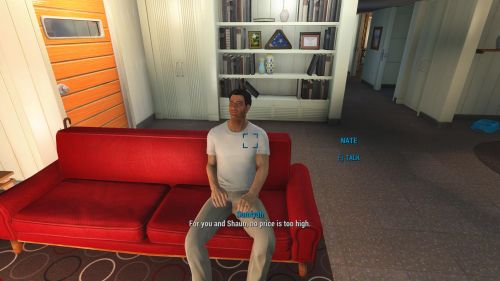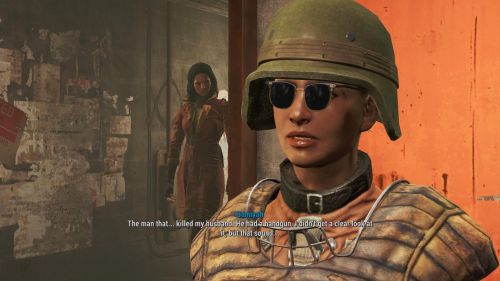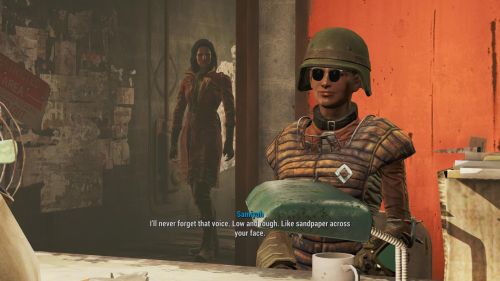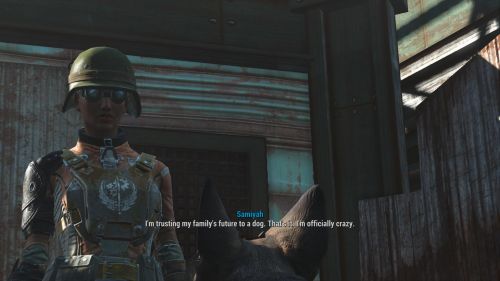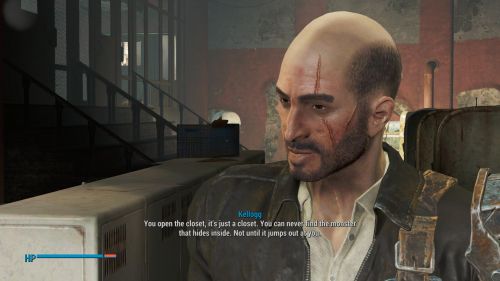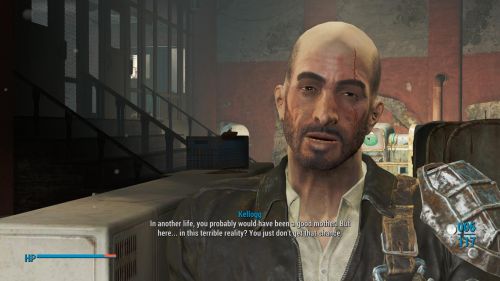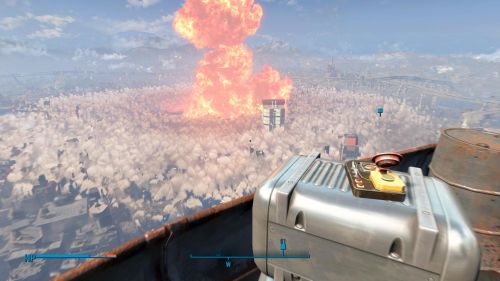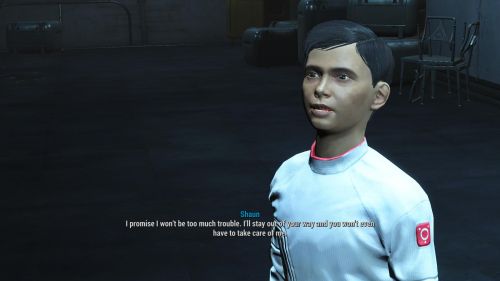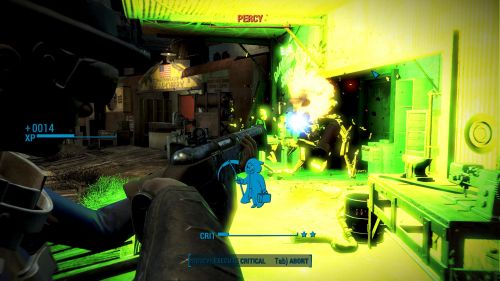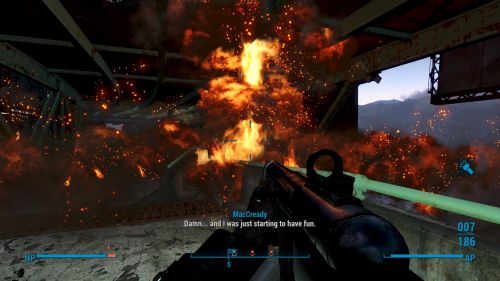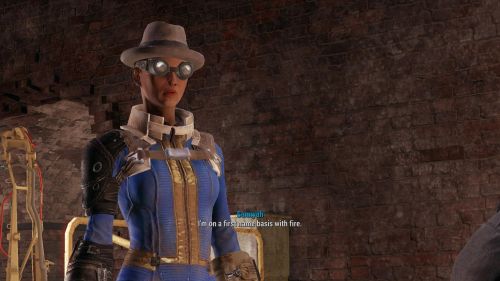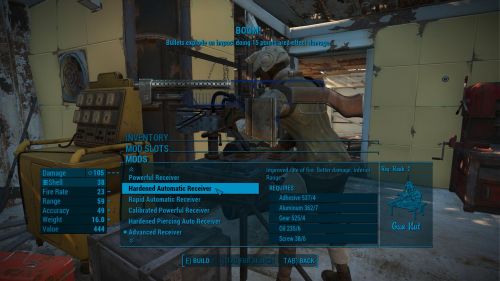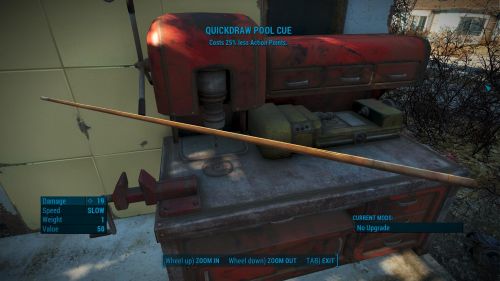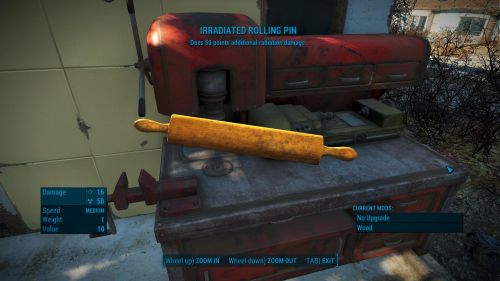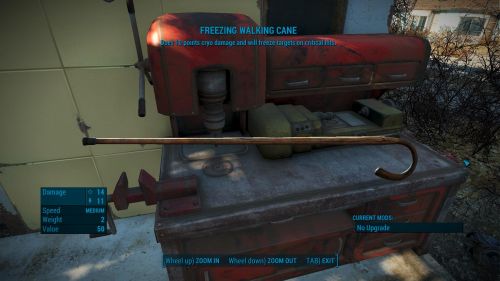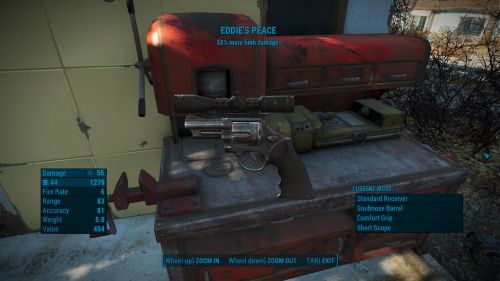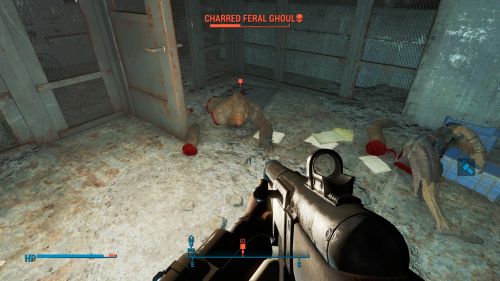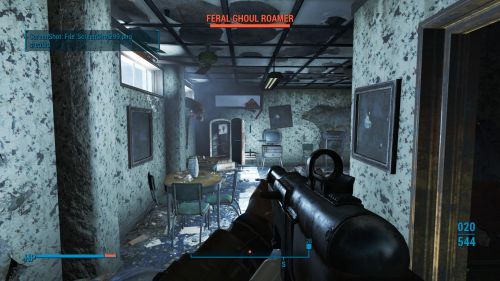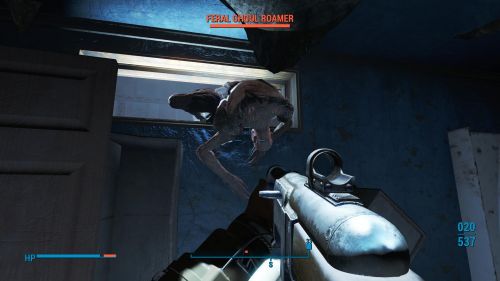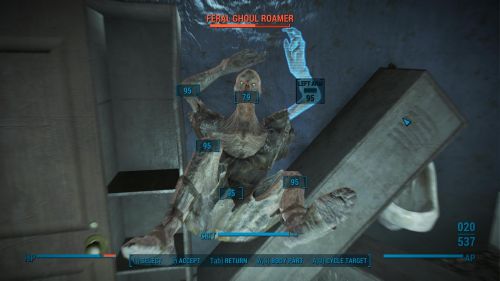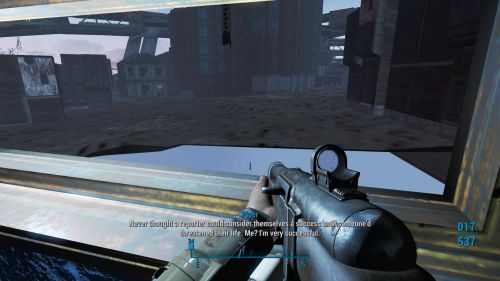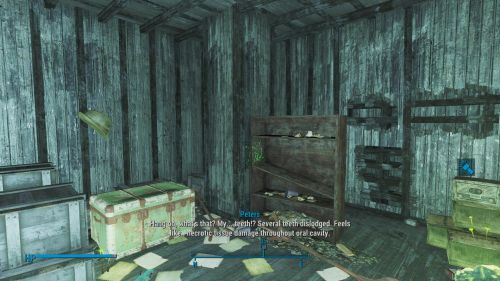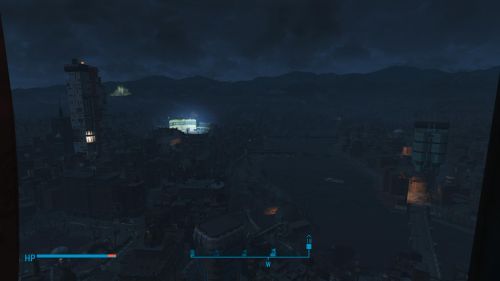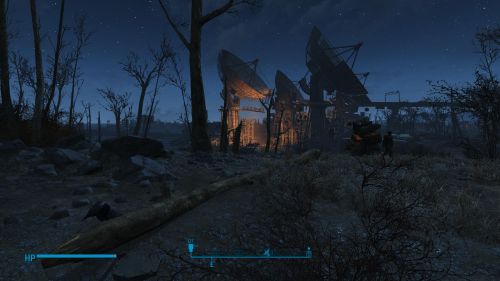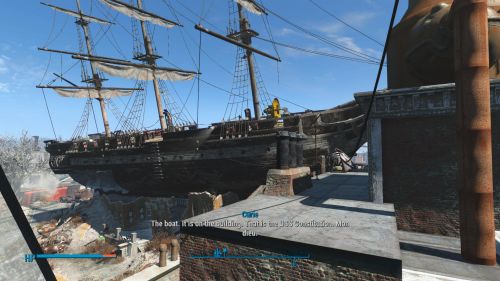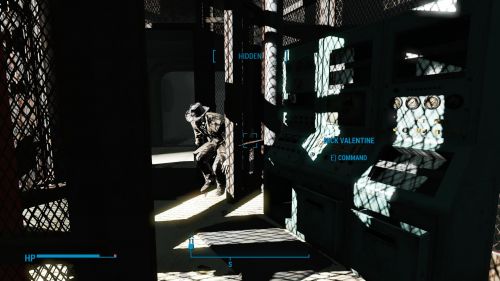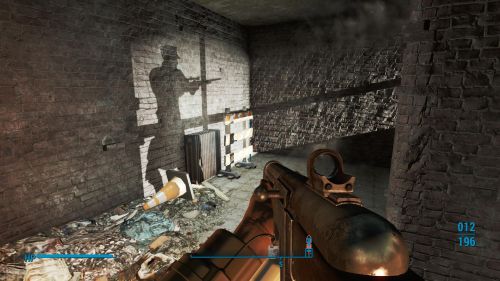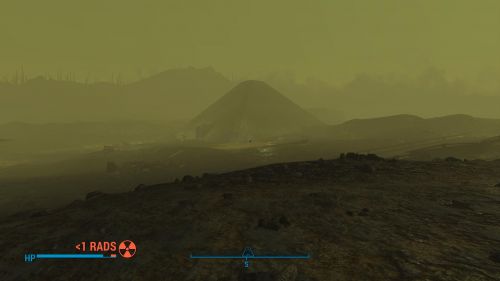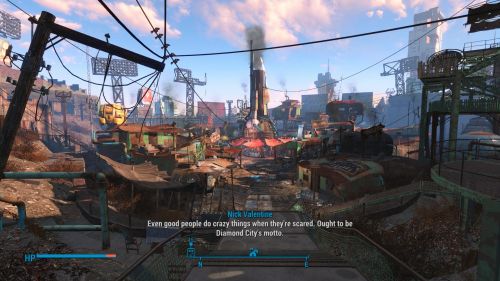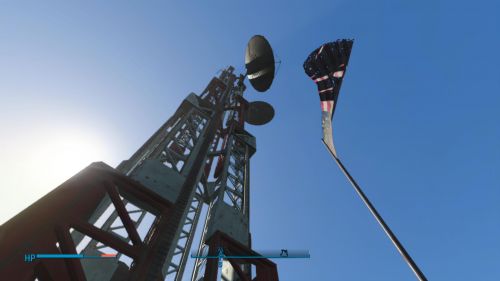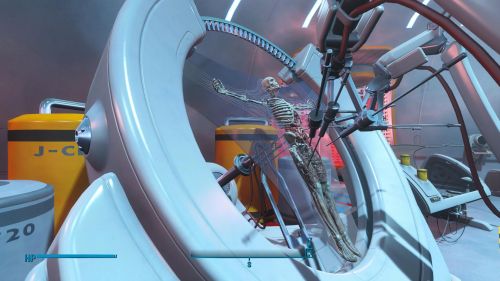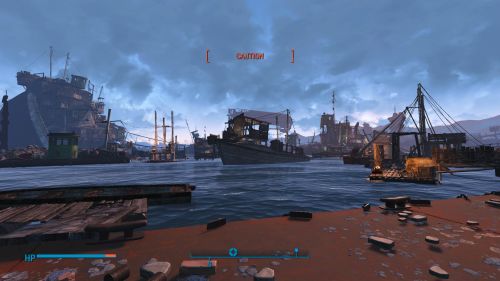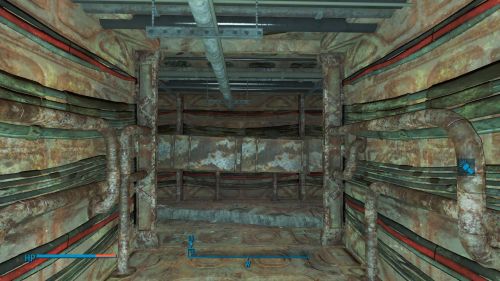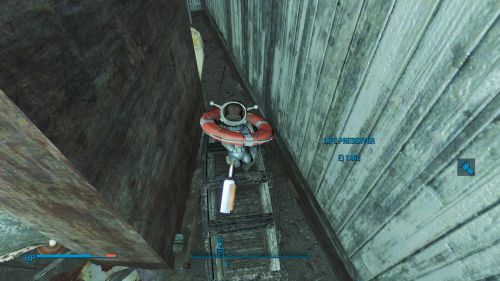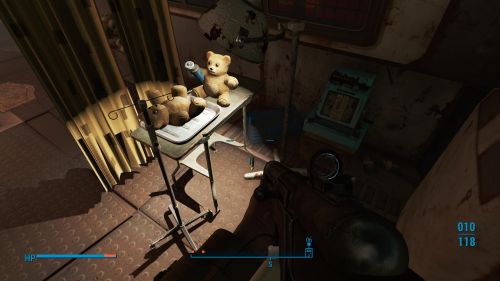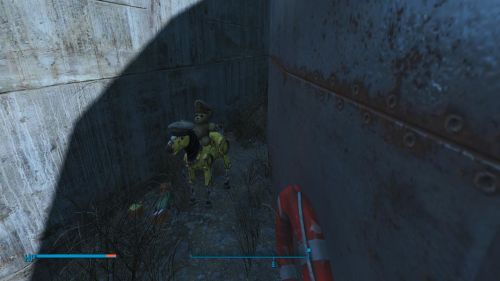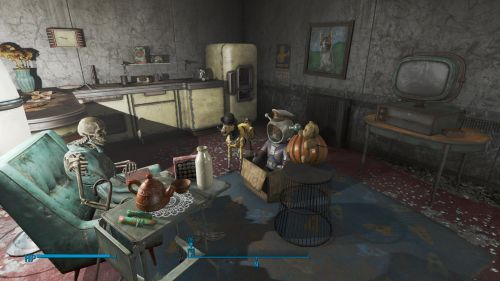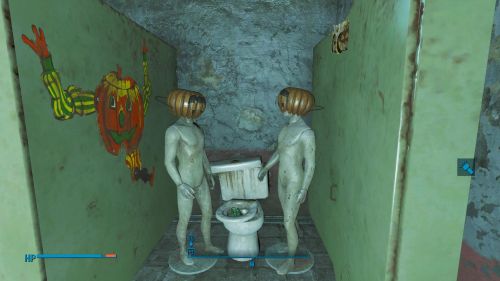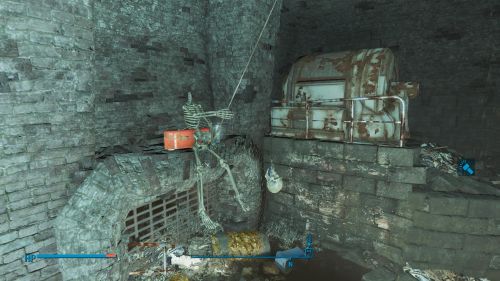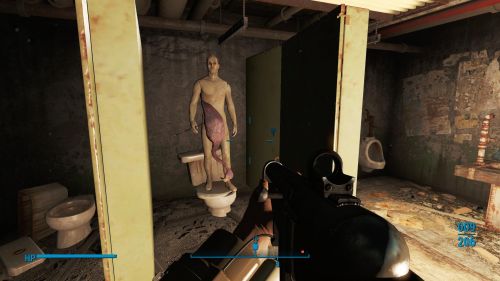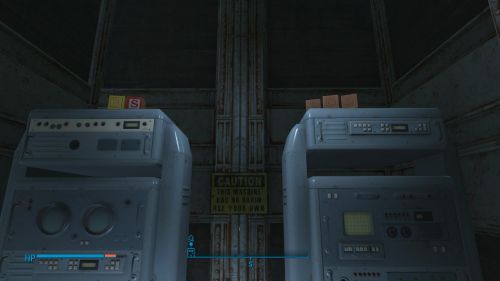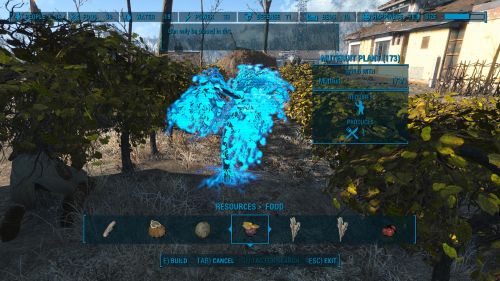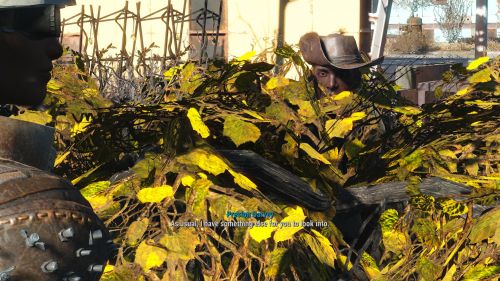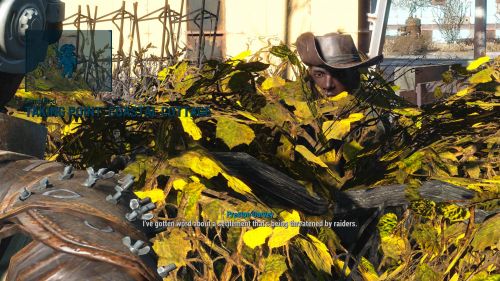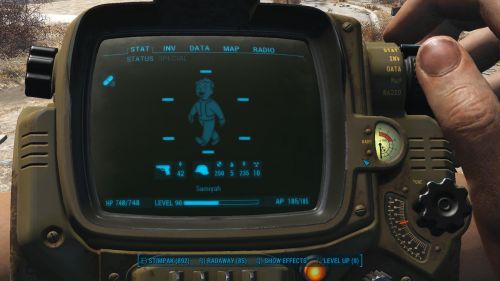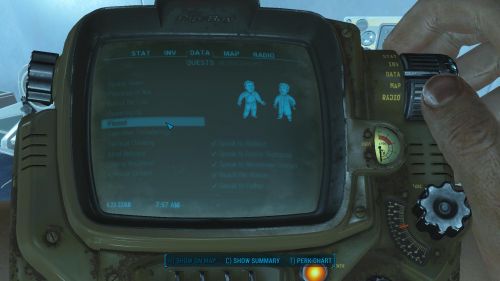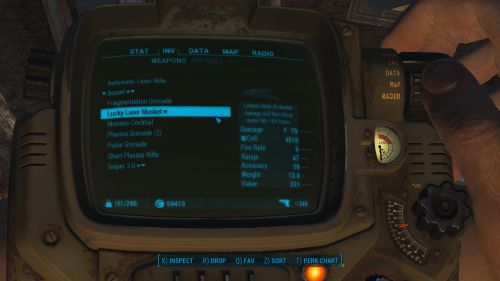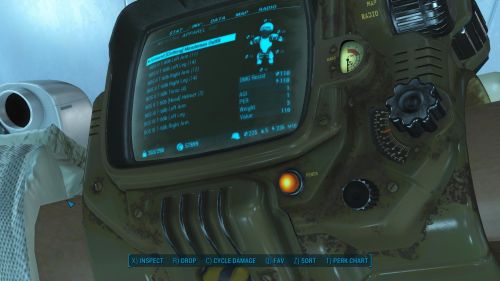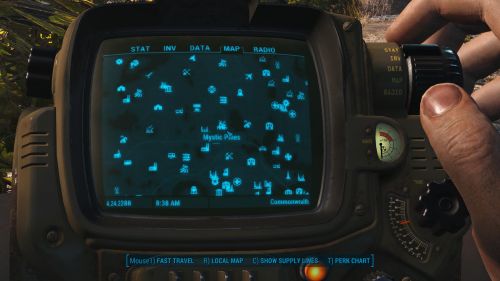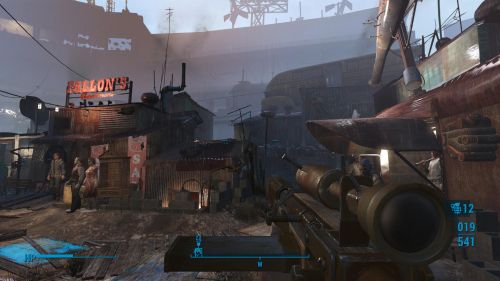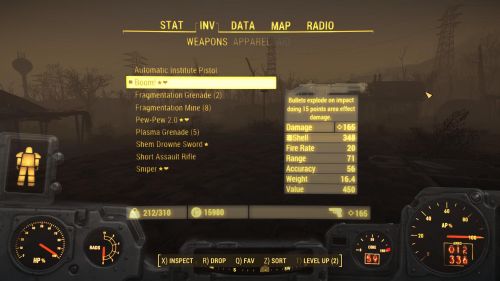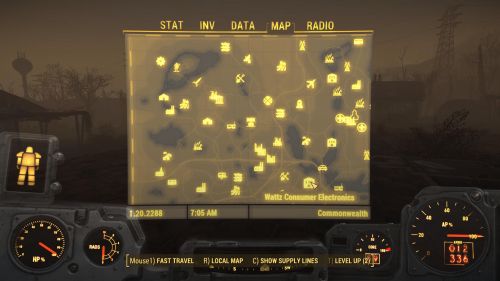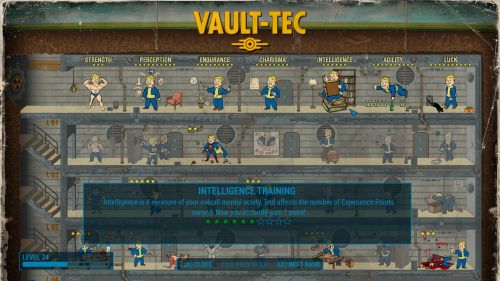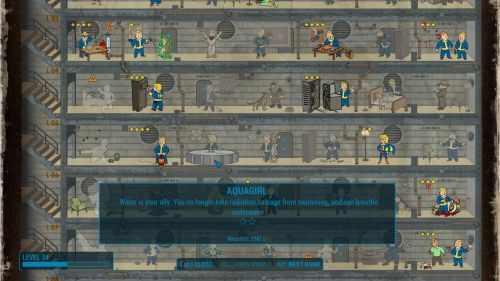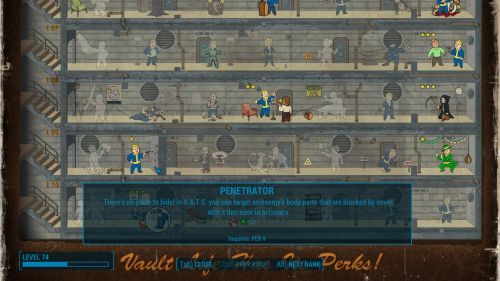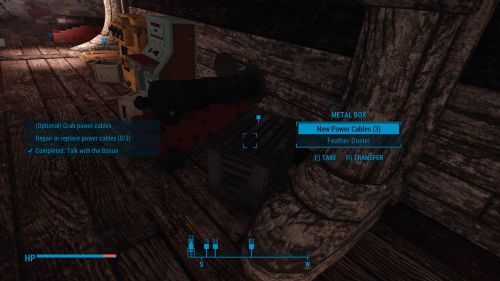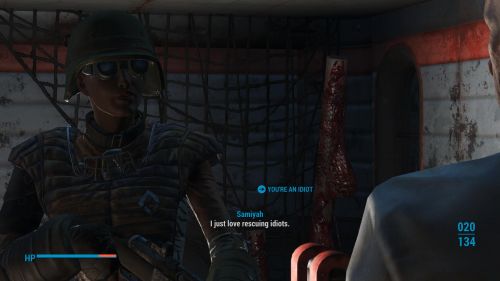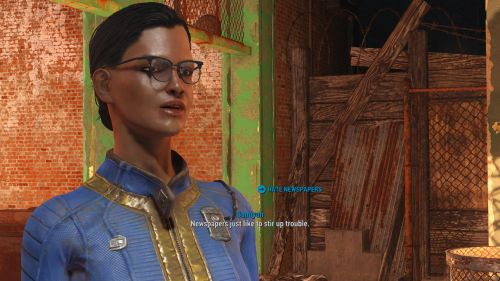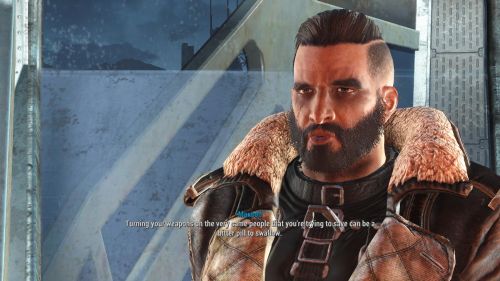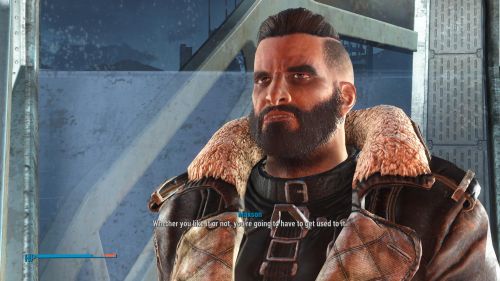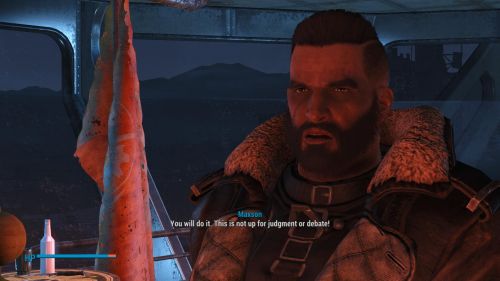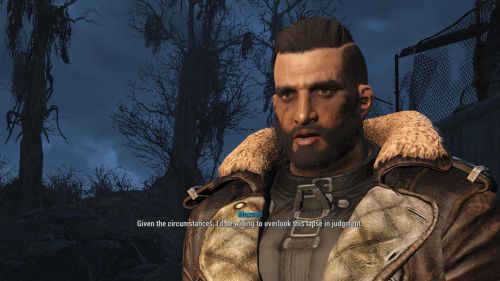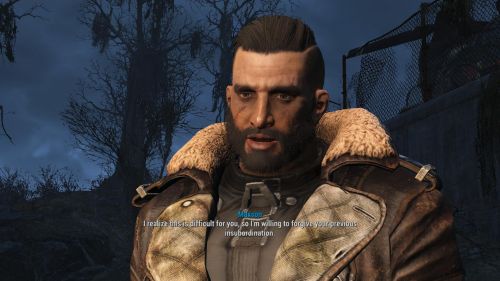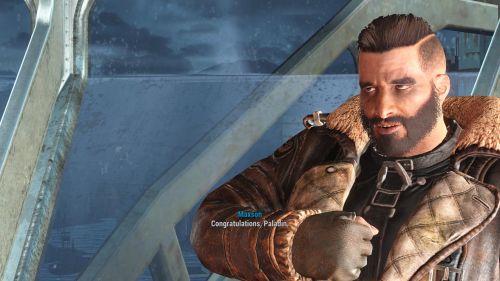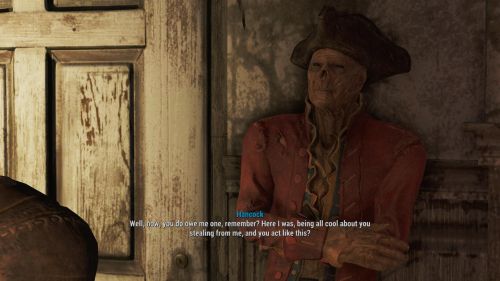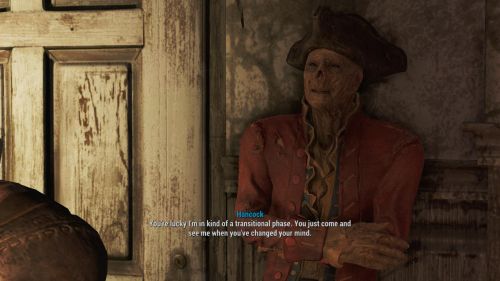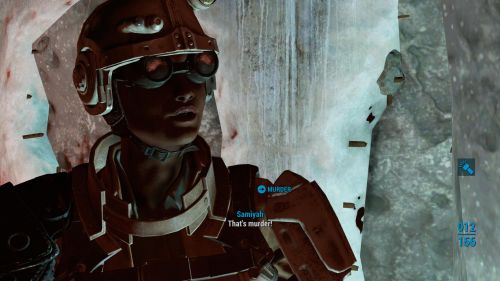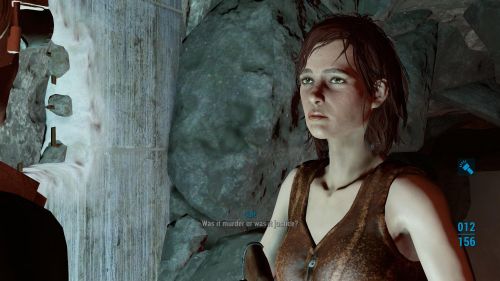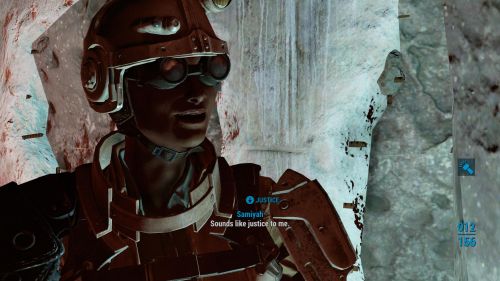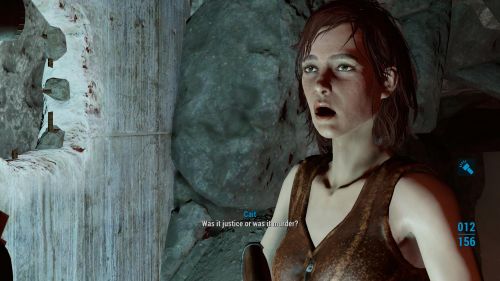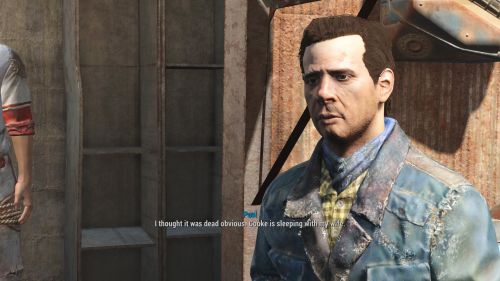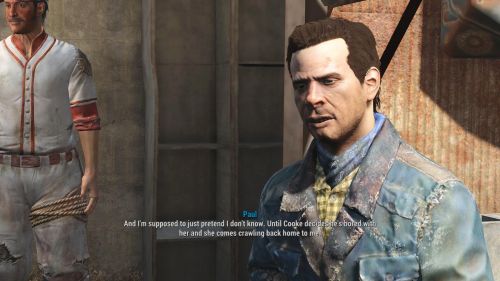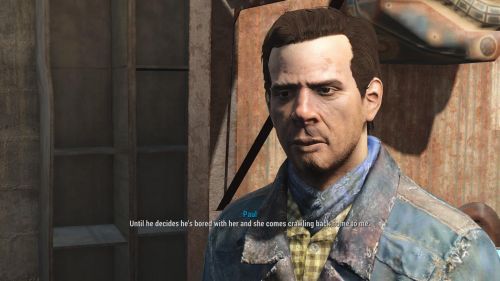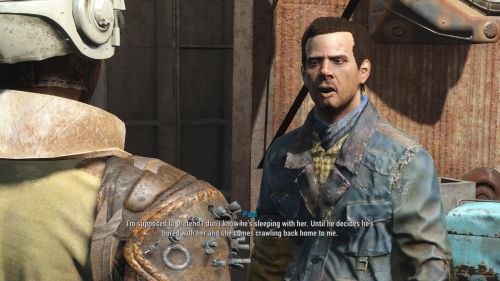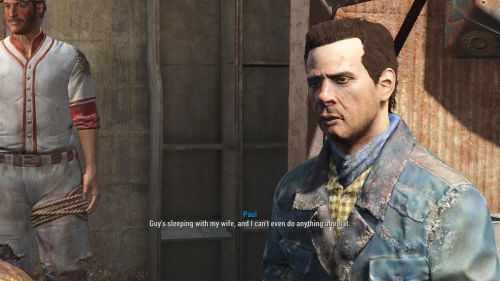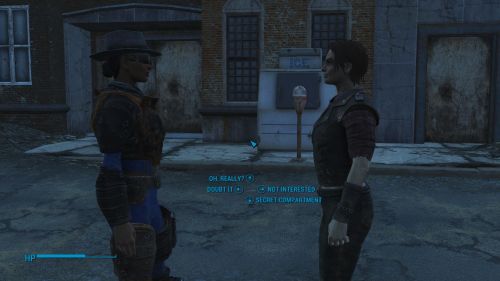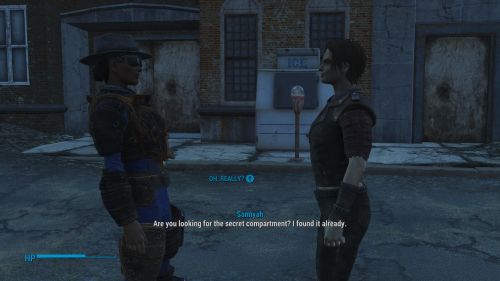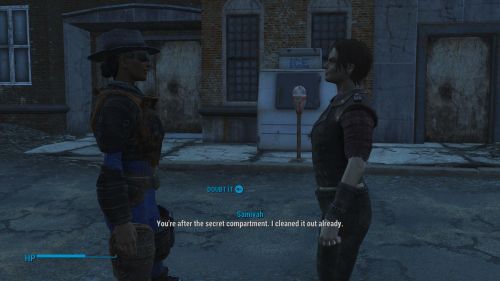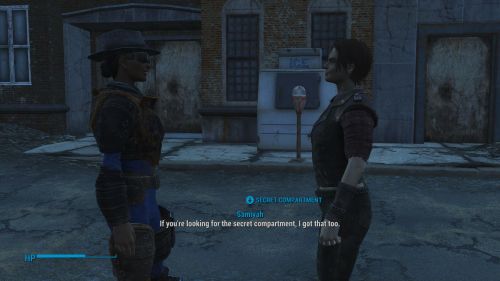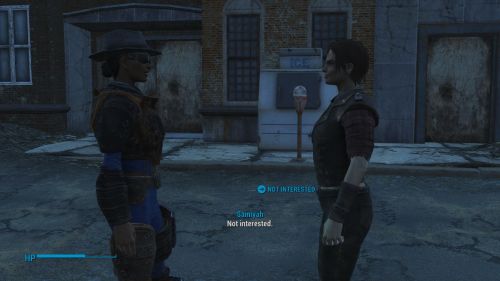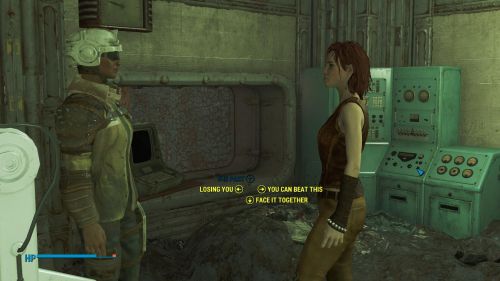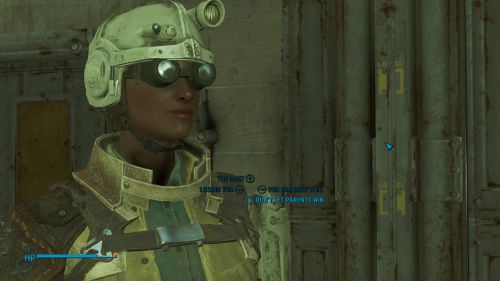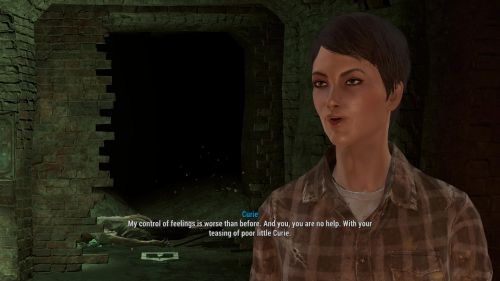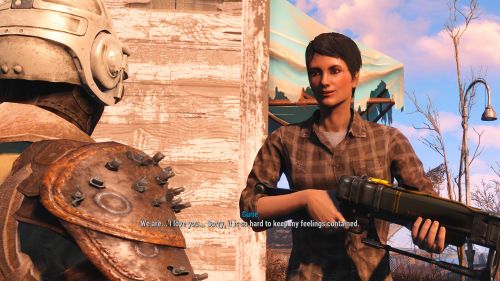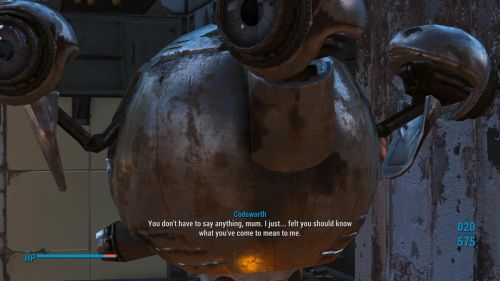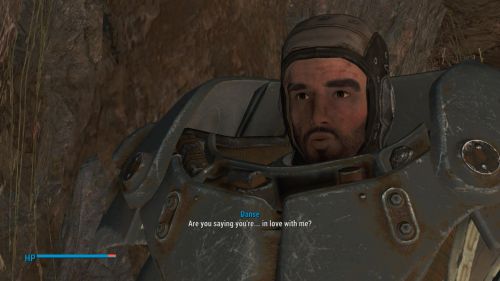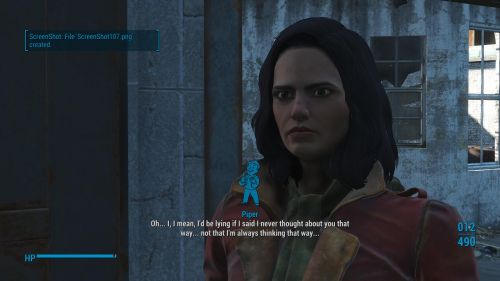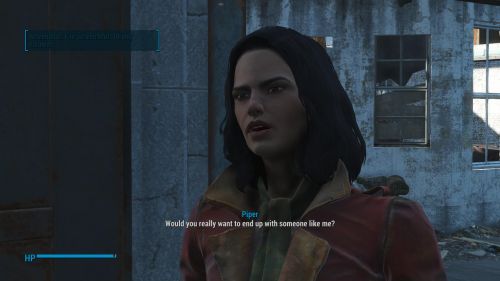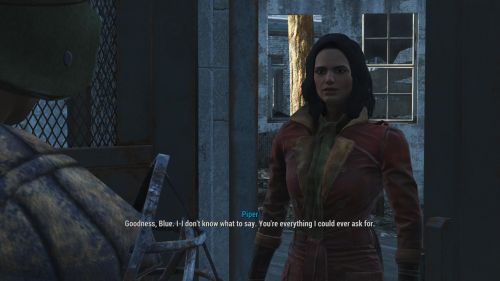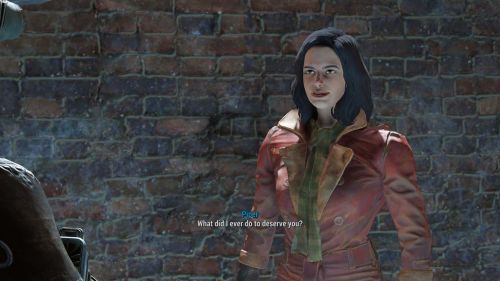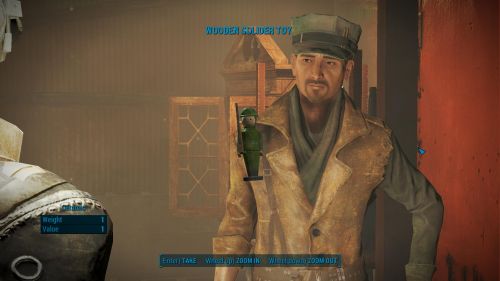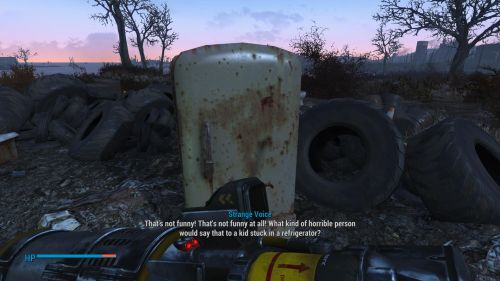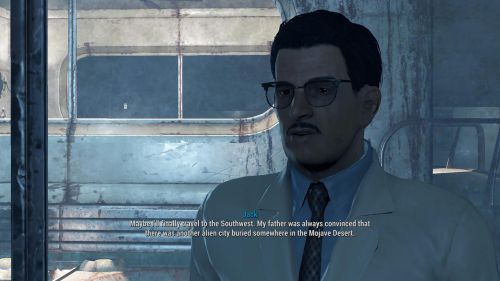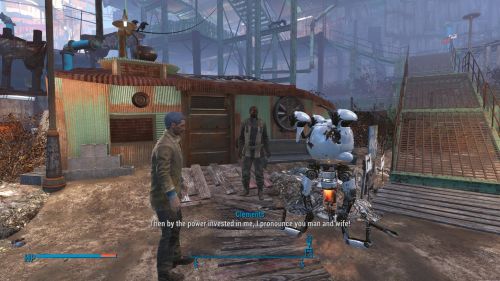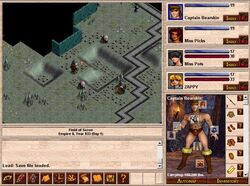13 Shocking Facts about Fallout 4 That Will Forever Change the Way You Think about RPGs
13 Shocking Facts about Fallout 4 That Will Forever Change the Way You Think about RPGs
Review - posted by Bubbles on Sun 10 April 2016, 20:41:34
Tags: Bethesda Softworks; Fallout 4It's the Year of Bethesda here at the RPG Codex, and we continue our coverage of the most successful RPG developer of all time with an exclusive look at their latest game, Fallout 4. It's written by one of my favourite front page writers, and he has a lot of insightful things to say about the game:
Yes, but did he like the game?! Follow this MUST CLICK link to find out: 13 Shocking Facts about Fallout 4 That Will Forever Change the Way You Think about RPGs
...it's perfectly logical that a decent, functional dialogue system would allow for a variable number of possible dialogue choices. That's how most RPGs have implemented their dialogues, and that's a perfectly sensible way to do it. Unfortunately, Bethesda chose a different path in Fallout 4 – here, you are always presented with exactly four dialogue options, no matter what situation you are in. This kind of strict formal requirement straightjackets the entire dialogue system; every single conversation node has been twisted into a neat “pick one out of four” pattern. Like so many things about Fallout 4, it's completely unclear to me why the designers have made this choice; maybe it's because controllers have four primary action buttons. Whatever the reasoning, the end result is a broken and unnatural dialogue system that is bloated with pointless choices.
...As it is, I got the feeling that Bethesda were more concerned with making the game look fun and visceral and exciting and “Whoa!” instead of actually doing the hard work of making it play that way.
...Intelligence gives 3% bonus experience per level and reduces the number of possible solutions shown in the hacking minigame. And that's it. That's what being intelligent means in the sequel to Fallout 1 and 2. Why couldn't they just remove the damn stat altogether? To be perfectly fair, Intelligence is also used for the three only (!) proper stat checks that I found in the entire game world, but that's not exactly a reason to rejoice and praise the Incline.
...It's no hyperbole to say that the writers at Bethesda are some of the worst storytellers in the AAA gaming segment. They are fatally attached to the idea of making a cartoon world full of cartoon characters living through Very Serious Stories. Unfortunately, this combination of narrative elements clashes rather badly, and results in a bunch of utterly idiotic stories that positively dare the player to find any sort of intelligent design behind them.
...And here's my analysis: Jesus Christ, are you fucking kidding me?
...As it is, I got the feeling that Bethesda were more concerned with making the game look fun and visceral and exciting and “Whoa!” instead of actually doing the hard work of making it play that way.
...Intelligence gives 3% bonus experience per level and reduces the number of possible solutions shown in the hacking minigame. And that's it. That's what being intelligent means in the sequel to Fallout 1 and 2. Why couldn't they just remove the damn stat altogether? To be perfectly fair, Intelligence is also used for the three only (!) proper stat checks that I found in the entire game world, but that's not exactly a reason to rejoice and praise the Incline.
...It's no hyperbole to say that the writers at Bethesda are some of the worst storytellers in the AAA gaming segment. They are fatally attached to the idea of making a cartoon world full of cartoon characters living through Very Serious Stories. Unfortunately, this combination of narrative elements clashes rather badly, and results in a bunch of utterly idiotic stories that positively dare the player to find any sort of intelligent design behind them.
...And here's my analysis: Jesus Christ, are you fucking kidding me?
Yes, but did he like the game?! Follow this MUST CLICK link to find out: 13 Shocking Facts about Fallout 4 That Will Forever Change the Way You Think about RPGs
“Deep into that darkness peering, long I stood there, wondering, fearing.”
Nick Valentine, Fallout 4
Nick Valentine, Fallout 4
There can be no question that Fallout 4 represents an important milestone in RPG history. Ask the average mainstream gamer what the best designed, most atmospheric, most memorable, best written, and overall biggest and greatest RPG of 2015 was, and they are almost certain to reply: “The Witcher 3”. However, if you ask them about the best-selling RPG of the year, they will assuredly point to Fallout 4. With a record-shattering 12 million copies shipped on launch day alone, Fallout 4 is poised to overtake Skyrim as the best-selling RPG of all time and become an important cultural touchstone for the next generation of RPG publishers, PR agencies, developers, and fans alike. In the years to come, Fallout 4 will be crucially important to everything we say and do as an RPG community, and every member of these forums should spend at least a few dozen hours of their time playing and studying the game.
For those of you who are currently unwilling or unable to invest precious leisure time in Fallout 4, I have drawn up a short list of basic facts about the game. If you wish to understand the unique combination of design elements that makes up one the most successful RPGs of our times, you should study this list closely.
1. The main storyline is completely unsuitable for an open world game
Bethesda's games since Oblivion have all had very similar openings: the player character is dropped into some sort of highly cinematic AAA situation full of shocking twists and turns that will leave story lovers of all ages hyped for the game's main narrative, while simultaneously introducing them to gameplay concepts like using the movement keys to move around and mashing the left mouse button to damage things. Those players who care more about exploration than cinematic storytelling will have to grind their teeth and follow along with the linear opening for a while, until they are finally rewarded with a grand reveal of the game's open world landscape. I don't know why Bethesda do things this way. Games as old as Morrowind and as recent as New Vegas and The Witcher 3 have simply opened with an intro cinematic followed by a few conversations and a short tutorial, and that seemed a perfectly adequate strategy to keep players interested in the game. But Bethesda aren't Obsidian or CD Projekt, and they aren't the company that made Morrowind either. Bethesda insist on doing things their own way, and that means railroading new players down a long track of inane conversations and pointless time wasting exercises.
Here's how Fallout 4 begins: the male player character narrates a long intro video about the state of the world in 2077, a period of uncertainty and war. He talks of his time as a soldier in the US army and opines philosophically: “War. War never changes.” Then the game shows the male protagonist together with his wife and their little baby boy Shaun in their pretty suburban home near Boston, and you get to choose whether you want to play as the husband or the wife. The game obviously wants you to choose the soldier husband, so I chose the wife instead; she's a homemaker with a law degree. No matter whom you pick, your first few minutes in the game are spent doing various suburban things like making date night plans with your spouse, playing with your son, getting a new nose, watching TV, and rolling your SPECIAL stats. Eventually, sirens start to blare and soldiers ferry you towards the nearby Vault 101, where you're cryogenically frozen and whisked away to a better time. You briefly wake up to see bad guys murder your spouse and steal your darling Shaun from their dying arms, then you fall asleep again, then you wake up again, say goodbye to your dead husband/wife and all the other dead bodies lying around, punch out a dozen radroaches, read a couple of terminal entries revealing the dastardly secret experiment of the vault (“freeze a bunch of civilians and see what happens”) and finally step out into the vast open world of the year 2287. Your mission, should you choose to accept it: Find your kidnapped baby and avenge your dead spouse!
There are two major problems with this intro. Firstly, it's really astoundingly boring. The husband in the opening cinematic talks about crippling resource shortages, the threat of total annihilation and the terrible fear he feels for his wife and child, but the domestic scenes in 2077 only show an idealized version of 50s suburbia with a bit of high-tech thrown in. The developers probably wanted to make your character's pre-war life seem as idyllic as possible to heighten the tragedy when the bombs start to fall. To me, however, this pitter-pattering husband-wife couple with their cute little baby seemed so fake and dull that I could hardly wait for their world to get wiped off my screen. Was I supposed to be shocked and distressed when my character finally got frozen and was transported to a slightly more interesting future? Was I supposed to care when my simpering toad of a “soldier” husband took a bullet in the gut? I'd barely known the guy for ten minutes!
Secondly, going after your missing baby strikes me as one of the most pressing and (theoretically) time sensitive goals a person can receive in their lives, and forcing this motivation on the player character of a “do whatever you want” open world game is downright criminally stupid. Every other open world RPG I've played handles this issue better by giving the player various outs to rationalize ignoring their primary objective: “it's all prophesied anyway”, “fighting bad guys will help win the war”, “I don't really care about this stuff,” etc. etc. But you cannot very well pretend that you don't care about your missing baby, especially when your fully voiced main character bleats out a mournful “Shaun! Shaaaaun...” at the slightest provocation. Worse yet, Fallout 4 drags the kidnapping storyline out for a good long time, leading you through the game's two biggest settlements and into the most dangerous high level areas on the overworld map in the process. Who could be blamed for taking a couple of side quests and building a few shacks for the homeless on the side? Why not wander out into the swamp and collect some baseball memorabilia? The main quest absolutely requires your character to care deeply for their child; the general world design beckons you not to give a damn.
After you get to a certain stage of the kidnapping investigation, the main quest abruptly transitions to faction warfare. At the heart of the conflict is a group of synthetic humanoids, or “synths”; these lifeforms have been created by a group of mad scientists to infiltrate and manipulate human society in the Commonwealth. The nuanced and complex ethical issues surrounding artificial life have been reduced to utterly simplistic faction philosophies that can be understood even by Xbox One owners: the Brotherhood of Steel are racial supremacists who want to exterminate all non-human sentient life, the Railroad believe that synths are 100% equal to humans and must be freed of all shackles, the scientists from the Institute are abusive slave holders who treat the synths as mere objects, and the exceptionally dull Minutemen just sort of care about people, you know? You must align yourself with one of these factions to take control of the Commonwealth, and you may very well end up having to kill some of your former allies and companions to accomplish that goal.
“Wow, that's great!” you might think, “finally I get to engage in some dynamic, open world warfare powered by the legendary Radiant AI!” Unfortunately, Bethesda were either unwilling or unable to implement the kind of robust faction system that Obsidian already realized 5 years ago in New Vegas. There's very little actual warfare or conquest going on in Fallout 4, and the main quest makes a rapid transition from “all right, now it's war!” to the final mission and the annihilation of your faction's enemies. And yet, I found these rushed final missions far more interesting and engaging than all the “Where, oh where is my little baby boy?!” stuff of the preceding 85% of the main quest. In a better game, the inter-faction conflict could have been the centrepiece of the main storyline; the developers could have taken advantage of the inherent open world nature of warfare to integrate side quests and exploration gameplay with your character's personal objectives to create a much more coherent story experience. I do not understand why Bethesda's Fallout writers have become so enamoured with these insipid family-based storylines when there are far more interesting and entertaining options available.
In the end, even the designers seem to have become tired of the missing kid plot. Three of the game's endings (virtually identical to each other) simply recycle the "blowing up Megaton" moment from Fallout 3; you needlessly nuke one of the most valuable and powerful assets in the entire Fallout world, and get a pat on the back for it. Then we get a short “final” cutscene where your character pledges to work for a better future by doing randomly generated kill and fetch quests for the rest of their natural life. “This time I'm ready, because I know war. War never changes.” Yes, quite. Afterwards, the game shoves a new kid at you; he's a substitute for your lost baby boy, and he says “I love you, mommy!” a lot. He can also “fully take care of himself” and requires no parenting whatsoever, leaving mommy free to scour the local deathclaw caves in search of cement bags and old hairbrushes. Everything about these endings feels improvised and perfunctory; I'm going to be charitable and assume that they were hacked together at the last minute due to some unavoidable production issues.
Only the fourth ending makes an attempt to resolve the story on a more personal note, ending not with an action piece, but with a conversation. The designers try their best to create a sad and somber final scene, only to immediately transition into a cutscene that's almost identical to the other three endings: “The past is dead, my family is gone, the future is fetch quests, clear eyes, full hearts, war never changes!” The main storyline aches so very very badly to be taken seriously, but it never even offers a proper payoff: the main character has no time for grief or reflection, because there's more randomly generated open world gameplay to do, and mourning clothes don't have good armour stats.
If there were any Fallout 4 players who actually cared about the main story up to this point, none of these endings should even remotely satisfy them. And what enjoyment is the average “I wanna wander around and do cool shit” player supposed to derive from a weepy baby-snatching plot? Why bother to write such a personal story if you can neither make it interesting, nor integrate it into the open world gameplay? What kind of storytelling potential could the designers possibly have seen in this plot? It's a mystery for the ages.
2. It's a 100+ hour shooter, with all that entails
When I do a review playthrough, I try to experience every aspect of the game, do every quest, speak to every NPC, and explore the entire world map. This way, I was able to get a very precise idea of what Fallout 4 could offer, and what it could not. My final save game claims that I spent 127 hours in the game; in that time, I had discovered 333 locations and killed slightly over 4,000 enemies in total. These stats are not terribly surprising; Bethesda's games are heavily focussed on action. They also offer other gameplay elements – most notably, exploration and managing your equipment –, but those are secondary to the core gameplay of hitting things over and over again until they are dead.
But how long can this kind of action-centric gameplay stay interesting? For the first few hours after the prologue, the game supplied me with lots of novelties to keep the infantile regions of my brain occupied; new types of enemies were waiting behind every corner, every dungeon revealed a new environmental tileset, and I constantly found new upgrades for my equipment. There was even an entirely new layer of gameplay to discover: I could found my own settlements, recruit settlers, and even create custom buildings! In these early stages, the game held almost infinite promise. Who knew what wonders the next dungeon might hold? What kinds of cool weapons were there to discover? How many complex and intellectually stimulating quests might I encounter? How many zany NPCs would I meet? Would Moira and the citizens of Little Lamplight make a cameo? The future of RPG design was stretching out before me as an undiscovered country. I did not expect such a strong sense of variety and mystery to be sustained over the whole length of a 127+ hour open world game, but I did expect the developers to distribute enough interesting experiences and challenges throughout the breadth of the game world to keep a playthrough entertaining from start to finish.
I made a conscious effort to keep the gameplay fresh and interesting for as long as possible: I mixed main quests with side quests and free exploration. I explored all the crafting options and tested out every weapon I found. I talked to every NPC I encountered, I went hunting for specific items, I tried to beat enemies who were 30 levels higher than me, and I dabbled in constructing my own settlements. I played on the highest difficulty level to maintain the greatest possible level of challenge for the longest possible time. I was gifted a suit of power armour within the first three hours of the game and abandoned it in the wilderness soon afterwards, simply to keep the gameplay interesting. And after about 20 hours, all of the gameplay elements apart from combat and exploration had become tedious. The main quest was best ignored, the side quests had blurred together in a haze of “kill this” and “fetch that”, and the NPC dialogues were abhorrent beyond mortal comprehension. Consequently, I resolved to simply ignore my quest log, stop talking to the NPCs, and just walk around the countryside entering random dungeons and blasting whatever wandered into my sights. It certainly wasn't challenging or simulating, and it wasn't how I usually like to spend my time in an open world game, but it was the most entertaining way to play Fallout 4.
As my character became more and more powerful, the gameplay gradually turned into a repetitive clickfest where I killed the same old enemies over and over again, finding fewer and fewer pieces of useful loot each time and becoming less and less interested in the world design. After about 50 hours, I no longer applied any tactical thinking to the combat; I just killed everything in my way and gawped at the occasional bit of pretty scenery. By that point there were still 77 hours left to play, including most of the main quest and almost all of the side quests. The gameplay was still barely tolerable, but it had long ceased to be entertaining: playing Fallout 4 had become nothing more than a test of endurance. I know what crushing tedium looks like; I've finished Dead State. This was worse. If I hadn't promised to review Fallout 4 for the Codex, I would have abandoned the game long before I hit the halfway mark.
Was it preordained that my playthrough should be so soul-crushingly dull? Are open world games inherently incapable of sustaining their breadth of content with adequately complex and interesting gameplay mechanics? I don't think so. The release versions of Morrowind and New Vegas kept me entertained for upwards of 100 hours, and modded Skyrim (including the Requiem overhaul and the charmingly degenerate Interesting NPCs mod) was good enough for an enjoyable 260 hour playthrough. The fact that Fallout 4 already starts to run out of steam at the 20 hour mark is entirely Bethesda's fault. Fallout 4's basic gameplay elements could make for a competent and relatively enjoyable open world shooter; in practice, however, the game is simply too shallow and too boring to be much fun.
By the way: Bethesda are currently beta testing an overhauled Survival Mode, which is going to disable manual saving and “most autosaving”, forcing you to sleep in a bed in order to save your game. It also disables the in-game console, removes fast travel, adds hunger and thirst systems, adds weight to ammunition, and reduces the PC's base carrying capacity. Finally, it adds an “Adrenaline system” that rewards kill streaks with stacking damage bonuses, because that's just a natural fit for a hyper-realistic survival mode. Quoth Bethesda: “Adrenaline motivates the types of stupid decisions that always lead to the best water cooler stories." Cool, cool. Unfortunately, all of these changes are bolted onto a dangerously dull and stupid game that already struggles to fill its considerable playing time with any sort of varied or interesting content. Adding extra survival mechanics on top of that isn't going to make Fallout 4 any more fun; if anything, it's going to make it even more tedious than before.
3. A solid equipment system is hampered by poor game balance
One much-hyped feature of Fallout 4 is the new modding system, which allows you to tweak the stats on a weapon or armor piece to tailor it to your needs. You even make minor changes to the weapon model itself! Unfortunately, your modding options are usually fairly straightforward in practice; you pick the receiver with the highest damage output, the sniper barrel with the longest range, and the biggest and fastest magazine available while ignoring the minimal trade-offs. Sadly, the weapon balance in the game is also quite bad, and many weapons are nearly unusable on harder difficulties. As a result, I found my equipment progression to be very flat. I quickly found two weapons that worked better than anything else, slapped on the weapon mods that were available, and then I stared at these same two guns for the remainder of the game.
The modding system becomes a bit more interesting when you build a weapon for use in the auto-aiming VATS mode. In their infinite wisdom, the developers have decided that the speed of a gun in VATS should be directly related to its total weight; lighter guns fire faster and use fewer action points than heavier guns. Put a bayonet on a rifle, and it may only fire half as quickly as before. Similarly, putting a scope on a gun drastically reduces its VATS performance, while attaching gun sights slightly improves it. In practice, I always found it easy to work around these limitations (why would you want to put a sniper scope on a shotgun?) but the underlying idea of forcing the player to make meaningful trade-offs is appreciated.
Armour mods offer a different set of boosts: one of them can increase your carry weight, while another one can improve your radiation resistance or your ability to sneak. Power armour mods in particular have received a laudable amount of attention to make them even more overpowered than ever before; you can add everything from Tesla coils that shock nearby opponents to an automatic targeting system, to a personal stealth field, or even... a jetpack?!? Yes, Fallout 4 finally re-introduces a version of the old Levitate spell to Bethesda's open world games, allowing the player to slowly crawl upwards through the thick air of downtown Boston. There's no special gameplay involved, and the jet boost is very limited in its reach, but you may find enjoyment in hovering around for a bit and looking at the low-res roof textures that the artists never expected to be seen up close. The jetpack is one of those typical AAA “wow!” features that play great in pre-release trailers, but aren't good for more than 10 minutes of mild amusement.
There are also a few quirky mods that completely change the weapon they are attached to, like a “splitter barrel” that changes a plasma rifle into a plasma shotgun, or a “flamer barrel” that turns it into a plasma flame thrower. Unfortunately, the game's armour system meant that I never found these weapons to be of much use in combat. In Fallout 4, armour reduces all incoming damage by a percentage, but low damage attacks suffer a greater reduction than high damage attacks. Since almost all enemies in the game are armoured, this means that weapons with low per-shot damage like SMGs and miniguns feel consistently weak. The Damage Threshold system in New Vegas had a similar effect on weapon balance, but at least that game allowed you to load your weaker weapons with armour piercing ammunition as a tactical choice. By contrast, Fallout 4 only offers standard ammunition; all of the ammo variants like AP, incendiary, hollowpoint, JSP, surplus, +P, beanbag, coin shot, magnum, buck, flechette, pulse, etc. etc. ...they're all gone. You can't even craft ammo anymore. The reasoning behind these design choices is beyond my understanding.
In good Fallout tradition, the game additionally gives you a bunch of tools to turn combat your way, including craftable mines, grenades, as well as various types of extremely powerful drugs. In good Bethesda tradition, these items are also most useful in the early game, before the declining difficulty curve renders them largely irrelevant. Meanwhile, healing items are unbalanced in their own, special way: they are at least 100 times more common than they need to be. By the end of my top-difficulty playthrough, I had hoarded over 2,000 stimpaks from loot drops alone, and enough food items to heal myself to full health several hundred times over. I also had a good thousand units of Rad-X and Radaway each. This character had deliberately avoided the best type of armour, and hadn't even specced into defensive or medical perks; by all rights, I should at least have had a vague illusion of resource scarcity. Fallout 4 doesn't have a wear and tear system for equipment either, but maybe that's not such a bad thing – having to stop and repair your weapon every few dungeons wouldn't be particularly fun when you're already aching for the game to finally be over.
Legendary drops are another system with potential: the game randomly spawns powerful legendary enemies who drop one item with a special, often quite useful modifier upon death. Armour pieces may increase your SPECIAL stats or improve your performance in VATS mode; weapon mods may add a flat 10 damage to every shot (completely overpowered with shotguns) or increase overall damage by 25%. Legendary mods are crucial to Fallout 4's long term item progression; for roughly the last 60 hours of the game, virtually all of my equipment upgrades came in the form of legendary items. Unfortunately, choosing the highest difficulty also increases the spawn rate of legendary enemies, which means that you will soon get far more legendary equipment that you would ever have received on normal mode. I chose to play on the hardest difficulty to prevent the combat from becoming a simple clickfest for as long as possible, but the flood of legendary items I received only sped up the pace at which my character turned into a demigod.
One side effect of the legendary system is that unique weapon variants and effects have largely disappeared from the setting; gone are the days when you could find a hand-crafted variant of a standard weapon lodged behind every cactus and billboard in the game world. Fallout 4 just shoves the same old models and effects at you again and again, even recycling the same base model for two of the most common weapons in the game. Most of the “unique” weapons in Fallout 4 are just hand placed legendaries with unique names.
Overall, the game's weapons feel terribly lame compared to the kind of guns I remember from the FPS games of my distant youth, with projectiles that bounced off walls, lightning attacks that leapt from enemy to enemy, or guns with alternate firing modes that could lay grenades or push away enemies in close range. In Fallout 4, it's generally all “point and shoot”, with very little thinking involved. Even the much-hyped “Broadsider”, a cannon ripped straight from the deck of a historic warship, is nothing more than a heavy handgun with a really long reload time. [After I wrote this paragraph, Bethesda announced that they were going to add lots of cool new weapons through various paid DLC packages, including a gun that shoots chain lightning. This helps to explain why the base game weapons are so dull.]
There are lots of options and modifiers, but only a few of them are actually useful.
4. Enemies have a few new tricks, but they're still not very interesting to fight
In your travels through the world of Fallout 4, you are going to encounter raiders, super mutants, ghouls, robots, raiders, deathclaws, mirelurks, rat scorpions, mole rats, synths and raiders. My stat window tells me that I killed slightly over 1,400 humans in the game, and the overwhelming majority of them were raiders. Compared to Bethesda's previous games, these raiders are relatively smart; they don't only fire their guns, swing their machetes, and (on rare occasions) seek cover, but they also occasionally throw grenades and use rocket launchers that could instantly kill my low-level character. During the early game, I had to keep an eye out for the grenade indicator and be prepared to dodge around a corner to avoid a sudden explosion; that was fun. However, eventually I could just kill every raider before they even had the time to prime a grenade. Super mutants are basically tougher raiders with funny voices. The only noteworthy type of mutant are the “suiciders”, who carry a nuclear warhead that goes BEEP! BEEP! BEEP!, and if they come too close to you or your companion, they trigger a huge nuclear explosion. Fighting a suicider is as easy as entering VATS mode and shooting the warhead in their hand as soon as you see them; that usually kills most of the other mutants in their group as well. I really liked fighting suiciders, even during the endgame. Listening to the aggressive beeping sound was a welcome diversion from the usual ennui of combat, and the battles with them were always finished quickly.
Feral ghouls are distinguished by their surprisingly high speed and their ability to perform short-ranged leap attacks; they could be a threatening enemy if they weren't so easy to kill. In fairness, the developers seem to have recognized the fact that ghouls don't stand a chance against the player in a fair fight, and they've implemented a mechanic to make things more interesting. Before Fallout 4 was released, people had feverishly speculated how the acquisition of id Software would improve the FPS elements of Bethesda's magnum opus. Now, the answer is clear: the big contribution from id to the Fallout franchise are monster closets. Ghouls can now spawn right next to the player character and even behind him, crawling through conveniently placed windows, falling out of holes in the ceiling, or crawling up from behind bookcases. These “whoa! Ghoul alert!” moments are nicely animated, with each ghoul usually performing a spectacular rolling or tumbling manoeuvre as they fall through the air. Sadly, like most of Fallout 4's cool new features, these spawns quickly lost their novelty value for me. At one point during the early game I was exploring an attic that contained no enemies, a loot chest, and a familiar looking bookcase. I thought “ah, that's where the ghoul is going to come from.” And so it was. Ghoul spawns soon became utterly predictable, and since the monsters always needed a bit of time to get down from their shelves and windows, I could just pump bullets into them without ever putting myself in danger.
None of the regular opponents in the game are particularly thought-provoking either. Radscorpions and mole rats can burrow underground to get close to you, but they're not powerful enough to pose any threat. Regular deathclaws and mirelurks are as simple to kill as ever; don't let them get close, and shoot their soft spots with the VATS system. Robots can go into suicide mode, running up to you and triggering a huge nuclear explosion if you cripple their limbs before killing them; the clever solution is to adopt a “shoot to kill” policy, which always worked quite well for me. During the early game, you may struggle with raiders in power armour who soak up bullets like a sponge; the solution is to shoot them in the back to disable their energy cells and force them to step out of their armour. Thankfully, you can start the game with a perk that lets you shoot the energy cells from the front as well; you wouldn't want the game to be too difficult, after all. Almost everything else can simply be killed with a headshot in VATS.
Some of the boss monsters and a number of high level regular spawns also have a few dangerous tricks of their own: briefly going invisible and barfing highly toxic poison puddles onto the ground. Over the course of my playthrough, I fought exactly five invisible enemies; my winning strategy was to plant a few explosives and fire a shotgun in their general direction. Meanwhile, the poison barfing Mirelurk Queen was countered by circling behind obstacles and slowly pumping approximately 27 rockets into her. I greatly appreciated these short breaks from the usual "click to kill" gameplay, but these enemies were still too rare and too easily outwitted to make for a challenging combat experience.
On the other hand, all of the “legendary” mini-boss enemies in Fallout 4 are simply tougher and stronger versions of normal trash mobs, and they are dispatched in just the same fashion. Occasionally, these enemies will “mutate” after taking a few hits in battle, which causes them to instantly regain all of their health and improves their combat stats even further. Exciting stuff, no? If this kind of “Grr, now you've pissed me off! INSTANT MUTATION!” nonsense was meant to liven up the gameplay, it's failed miserably. At the very least, Bethesda should have used the mechanic for something cool like raiders morphing into deathclaws, or molerats growing a shell of power armour. That might have made combat a little less predictable, and it wouldn't have made the game any dumber than it already is.
Ultimately, I believe Fallout 4 would have been more entertaining if Bethesda had adapted even more elements from other hack and slash games. If the legendary enemies could spawn with interesting special powers, if there were more meaningful differences between enemy types, if there were a reason to use more than the same two or three weapons for most of the game, and if a properly tuned system of difficulty levels had been implemented to maintain a sense of challenge throughout a playthrough, then the gameplay would have been massively improved compared to what I forced myself to endure. As it is, I got the feeling that Bethesda were more concerned with making the game look fun and visceral and exciting and “Whoa!” instead of actually doing the hard work of making it play that way.
5. The world looks better and more varied than Fallout 3
Yes, it's true; for everything else that's half-assed and shoddily implemented in Fallout 4, the developers have obviously put a lot of effort into modelling the area of Boston and its surroundings in the game world. In Bethesda's older games, I was inevitably struck with a feeling of deja-vu – hadn't I been in this dungeon before? Wasn't this layout terribly, ominously familiar? How many draugr tombs could there be in Skyrim? Why couldn't all of these subway tunnels have collapsed already? These thoughts never occurred to me in Fallout 4, and that's high praise indeed. Bethesda have clearly put a tremendous effort into the visual design of their areas, and they're succeeded in creating a world that looks pleasantly varied and unique. Highways with makeshift elevators, a collapsed monorail leading onto a rooftop, apartment buildings, skyscrapers, country houses, trailer parks, hospitals, office buildings, historical landmarks, inexplicably preserved pre-war estates, post-war settlements, caves, basements, service tunnels, fallout shelters, factories for various items using different types of machinery – you can really see the millions of AAA development dollars at work here. The vaults and subway stations still look quite samey, but I assume that's intentional.
The area designers have also made better use of the vertical dimension than previous Bethesda games; most buildings have walkways, elevators, or holes in the ceiling, and secondary exits leading to rooftops or open-air bridges are common. They don't have much of an impact on gameplay, but they make the buildings feel a bit more lively and diverse. There's also a nice little scripted event in the starting area where you can drain a flooded quarry, only to later return and find that a group of enemies has built a new settlement inside the pit. How neat! Sadly, this is strictly a one-time event, and the rest of the game doesn't offer anything close to this kind of environmental manipulation.
Ultimately, the environments kept me entertained for longer than anything else in the game. The game world kept showing me things I hadn't seen before, whether it was an old satellite array standing alone in the wasteland, a mysterious pyramid towering over an irradiated crater, a humorously overlit sunrise scene, a terribly low-res crawlspace texture, or simply a room with some cool looking shadows on the walls. The release reviews have pointed to weak graphics as one of the worst elements of the game; in proud Codex tradition, I've come away with the opposite impression. The visual design of Fallout 4 is far more entertaining and varied than any of its gameplay systems.
In terms of dungeon design, the most noteworthy feature are the humorously posed skeletons, teddy bears, and toy monkeys strewn about. Fallout 4 is very big on this type of “environmental storytelling”, and they seem to have put a lot of work into this stuff. True, almost every dungeon crawl still amounts to a pattern of “enter at door, shoot everything that moves, find treasure room, loot, leave.” Yes, trap variety feels worse than in Skyrim, with swinging blades and trapdoors replaced by lame ol' mines and tripwires linked to explosives. And doing the same two lockpicking and hacking minigames again and again and again and again is really not fun at all. But look at these skeletons! They've been choking each other on top of a safe for over 210 years now! They must really hate each other! Why is this teddy bear reading a newspaper and holding a coffee mug? Bears don't drink coffee! Hey, are those letter blocks spelling words? Why? How?!? I don't understand! This is so awesome! And so on and so forth. These are instances where I have to accept that I'm not part of the mainstream target audience and simply move on; I only wish there had been a few decent puzzles in the game.
6. The player-built settlements do not add anything interesting to the game
Before the game's release, Bethesda had spent many hype dollars promoting the settlement mechanic – an entirely new gameplay area focussed on rebuilding civilization in a post-apocalyptic world! In theory, giving the player the ability to create their own communities should have had tremendous implications on the game world at large. If you built up every settlement in Fallout 4, you would have control over the lives of over 600 subjects, which would be over half of the total human population of the game world (raiders discounted). This could – and should – have made a major impact on the gameplay mechanics. How do you govern 600 people? Will you be a dictator or share power with local leaders? Are your settlements a safe haven for one of the factions, or are your settlers hostile to them? Should there be laws and regulations? Should there be a police force? Should you demand taxes for your services? How do you resolve conflicts between different ethnic groups and ideologies? There are a lot of interesting things you can do with this kind of gameplay mechanic, and Bethesda haven't done any of them.
In practice, the settlement mode is extremely shallow and limited. You can put down buildings in pre-designated areas on the world map, and then you can put tables and beds into them. Then you can watch a bunch of NPCs, all named “Settler”, sit at the tables and lie in the beds. You can randomly plonk down a water pump and a field of gourds and assign farming jobs to keep your settlers well supplied. Afterwards, you could put down electrical generators and manually run power lines to lights bulbs in every room in the settlement, so that your people can read at night without ruining their eyesight. And your reward for doing all of that would be a little stat counter telling you that your settlers are now happier than before. As I understand it, happy settlers are slightly more likely to give you passive economic bonuses and gift you with random crafting components, which might be quite useful if the game world wasn't already bursting at the seams with easy money and ample resources.
The other “reward” for your labours is an endless stream of dull-as-dishwater randomly generated radiant quests asking you to clear out dungeon X, rescue settler Y from dungeon Z, or to defend settlement A from a horde of randomly spawned mooks. Almost all of these quests are accepted automatically when you walk past an NPC, which is a truly evil design choice. Most of these missions are also under a timer, so ignoring them will eventually cause a big FAILURE message and a happiness loss. I'm sure some players could happily spend months of their lives doing this kind of stuff, but I had already seen everything the settlements had to offer within the first few hours of the game. Afterwards, I just let every quest fail and ignored the mechanic as best I could. At their best, Fallout 4's settlement mechanics are meaningless fluff; at their worst, they're a delivery mechanism for the most braindead kind of busywork.
7. The UI is still built around the Pip-Boy
Bethesda are not terrible at art design, and they are, to some extent, capable of fixing the worst flaws of their previous games. And yet, here we are, in the year 2016, and they have once again delivered one of the worst user interfaces of the Windows era. Look into your inventory, and you are greeted with a blurry mess that's riddled with scanlines. Who puts a blur effect on an inventory screen? Why can I only see ten items at a time? Why does the stats window only take up a fraction of the screen? Why does the right mouse button shake and tilt the UI instead of doing anything useful? Why can't I see a single damn thing on my character screen while I'm standing under a strong light? It's because Fallout 4's interface was not designed to be usable; it was designed to showcase the super-cool, super-immersive Pip-Boy™.
The developers seem to be enamoured with the idea that your Pip-Boy is a real, in-game item. Thus, its interface must be displayed on an actual in-game object that has been outfitted with a curved two-colour low-res screen that looks like a relic from the 1980s and becomes unreadable if the ambient light hits it from the wrong angle. They also insist on showing the player character's hand tweaking the various knobs and sliders on the Pip-Boy as you navigate the UI, because it makes players feel like they have a real, functioning Pip-Boy right in front of them! Actually, I never found any of these little features to be in any way “immersive” or “wow!”-inducing; they just cluttered up the screen.
With screen space so desperately limited, the game has to make numerous tradeoffs, splitting every single window into a humorous amount of sub-windows. The inventory alone consists of seven separate tabs, and the screen cannot even show all of the tab titles at the same time; you have to scroll through them. To see how much shotgun ammo I had, I had to open the inventory screen, press the right arrow key six times to scroll through the tabs, switch to the mouse wheel to scroll down a list of various items for a few seconds (there's no “jump to end” or “order from z-a” feature here), and stop at the item named “Shotgun Shell”. Of course, the ammo list is one of the shortest lists in the menu; when I wanted to get to the end of my collection of notes and quest items in the “Misc” tab, I had to scroll for 28 seconds. By the endgame, trying to find a specific item in my stash could take several minutes, especially since the game sorts weapons and armour by their mod names: a “Short Plasma Rifle” is listed under “S”, but an “Automatic Short Plasma Rifle” is under “A”.
I would probably be more tolerant of the Pip-Boy UI's clumsiness if its focus on creating an immersive in-game user interface had at least carried over to the rest of the UI. Instead, every design element that is not shown on the Pip-Boy follows a completely different design aesthetic. Your health bar, compass, and quest marker are shown in a minimalist interface that goes even farther than Skyrim did in wiping any trace of personality off your main screen. Your health is just a simple bar that becomes shorter as you take damage and grows longer when you are healed. Your compass is just a horizontal line with icons and quest markers on it, and your current weapon's ammo is simply displayed with two numbers in the corner of the screen. I actually like this design quite a lot; it's completely inoffensive, it doesn't get in the way, and you can even customize the colours if you're tired of the default puke green aesthetic. But this simplicity makes the Pip-Boy look even more abhorrent by comparison; it would be better if Bethesda had just scrapped that infernal piece of garbage entirely and gone for a minimalist no shaders, no scanlines look for the entire UI.
Bethesda have also come up with entirely new UI designs for their other gameplay elements, with generally bad results. The UI for the power armour is so awful that words cannot do it justice; it has to be seen in all its horror:
It's as if the designers have taken everything that was bad about the Pip-Boy and cranked it up to eleven. The UI for constructing your own settlement is also a mess: the placement menu has dozens of subgroups for each type of item and you cannot “favourite” a commonly used building element, you can only navigate the menus with the keyboard, and you have to place everything in first person mode. Normally, I would expect a settlement builder on the PC to offer mouse driven menus and an alternate viewpoint for placing large items at the very, very least; this UI is obviously nothing more than a straight port of a badly made console interface. On the other hand, the new character screen looks very different from the rest of the game. The designers have created a huge poster of a vault that spans several screens; you navigate through the poster by dragging it around with your right mouse button, because that's the obvious design choice. All the perks in the game as represented by little rooms in the vault, and each room has its own animation of Vault Boy doing something vaguely humorous. This type of concept-based character screen reminds me of Skyrim's star chart, which was a huge marketing success back in the day. Unfortunately, this poster doesn't seem to have attracted nearly as much media attention and general public be-wowing as its predecessor. Could people actually be getting tired of the beloved Vault Boy? Oh, what dark times we live in!
8. The character system is based on a good idea, but it fails in execution
Here's a controversial statement for you: what Bethesda have done to the SPECIAL system in Fallout 4 is a total butchery of the original design, but it's the good kind of butchery. It's a mercy killing. It is, in the great scheme of things, the decent and ethical thing to do. The SPECIAL system from the original Fallout games was designed to let players create a wide variety of different character types, utilizing both combat and non-combat skills. Your character was encouraged to be a decent fighter, but beyond that, the choice was yours: you could be everything from a fast talking doctor with a knack for elevator repair and a surprising aptitude for pugilism to a five foot tall expert sniper who was too stupid to speak properly. Logically, this system came with trade-offs and relatively difficult build decisions – you couldn't be good at everything. The original Fallout games used this system to create a world that reacted to your build choices; your character's weaknesses limited your gameplay options, and your character's strengths expanded them. Unfortunately, this is not the type of game that Bethesda make. Starting with Oblivion, the studio has focussed on creating simplistic, streamlined, minigame-heavy action games, where every piece of content is available to every character build. In their modern incarnation, Bethesda are just about the last RPG developer in the world whom I would entrust with creating a character-based gameplay experience. They have never done it, they obviously do not wish to do it, and I personally believe that they are utterly incapable of doing it.
I do not know why the studio insisted on using a version of SPECIAL for Fallout 3, but the resulting game was, in my most humble opinion, a horrible piece of garbage and one of the worst RPGs ever made. The developers seemed so horrified by the idea of gated or limited content that they made it very easy to max out every skill and basic stat you ever needed; with the DLCs, you could even make a “perfect” character who had 10 in every stat and 100 in every skill. This rather defeated the purpose of implementing stat and skill based gameplay in the first place, and also had the marvellous side effect of making every carefully crafted player character look almost exactly the same by the endgame. Furthermore, the developers clearly had no idea how to actually implement sensible skill checks in the game; your character ended up saying and doing the most idiotic nonsense in order to unlock a worthless reward or a meaningless reaction from an NPC you didn't care about. At least this final aspect of the design was thoroughly improved upon by Obsidian in Fallout: New Vegas. Levelling up and maxing out the skills was still far too easy in NV, but the game fully succeeded in offering a broad choice of different gameplay options for different builds.
If you had to make a character system for Bethesda's sequel to Fallout 3, how would you do it? I believe that following in New Vegas's footsteps and implementing SPECIAL again, but with lots of skill checks and a high degree of reactivity to the player's actions, would be out of the question. Not only would that require a level of writing and design talent that Bethesda plainly do not possess, but it would also turn FO4 into a more complex and nuanced game than the studio is historically comfortable with. Alternatively, you could rip out all the non-combat stuff from SPECIAL and turn it into SPEAL. Then, however, you'd be left with a system so shallow and simplistic that even Fallout 3 fans might complain about it. Thus, seeing no alternative, you would surely follow a third way: design a completely new system based on the most successful RPG of all time (yes, Skyrim), simplify it as much as humanly possible to appeal to a larger audience, make it more focussed on combat stats to properly match the gameplay, and retain the name SPECIAL for marketing purposes. Let's call this system SPECIAL 2.0.
There are a number of a factors that make SPECIAL 2.0 exceptionally well suited to the type of games Bethesda make. Most importantly, this is a simplistic, easy-to-understand character system that revolves entirely around perks. The skills have been removed completely, the trait system lies buried and forgotten, and the SPECIAL stats are simply perks with a different name. Meanwhile, the selection of perks has been expanded to 70 perks total (10 for each stat), and most of them have multiple ranks. Everything is bought with perk points; you get one point per level up, and you can use that point to buy a perk, upgrade a perk, or get a stat increase. As a result, the level-up process is simpler than ever before: just click on one of the big funny pictures of Vault Boy, and you're done. No scary numbers, no confusing tree structures, no worrying about splitting points between this skill and that one – it's just one click, and then you can go back to the gameplay. There are also very few prerequisites for any perk. Whereas Skyrim's perks were arranged into trees where buying one perk unlocked another, the perks in FO4 are simply unlocked by your basic stats. Do you want Penetrator, a perk that allows you to shoot through walls and instantly disable robots and enemies in power armour? Just increase your Perception to 9 and buy the perk. Or start with 9 Perception and buy Penetrator at your very first level up. It's devastatingly simple. It just works. Only the upgrades to your perks are limited by character level; for instance, if you want Penetrator to be more accurate, you have to wait until you're level 28 to unlock that new perk rank. This system is tailored to the thrill-seeking RPGamers of the 21st century: you can pick any neat and shiny perk that catches your eye right from the start, but you will still unlock powerful new upgrades (usually in the form of percentage boosts) as you level up. From a casual “drop in and just have fun with awesome perks” perspective, this must seem like a near-perfect system.
With SPECIAL 2.0 it's also extremely difficult to max out your character; you need to reach level 270 or thereabouts to buy every rank of every perk in the game, and even my completionist playthrough ended at level 74. Thus, you can only get about a quarter of the perks in the game without spending hundreds of hours grinding ghouls. Still, 70+ perk points is a lot. Imagine the possibilities for making intricate, multi-faceted combat builds, with many cool abilities that can be used tactically in specific battles! The people at Bethesda must have imagined these possibilities at well, shuddered in fear, and proceeded to clog the system with filler perks. Most of the perks have been rampantly recycled from previous Bethesda games, with everything from the Mysterious Stranger to the always thrilling “invest in stores to increase their available cash” making an appearance. Oh, and V.A.N.S., of course. Remember the glowing trail on the ground from Skyrim that always led you to your quest objective when following the quest marker proved too much of a challenge for you? No? Well, apparently a lot of people really liked it, and now it can be yours for just one single perk point. So much good stuff to choose from! On the other hand, if you're the hardcore powergaming type and can't get excited over spending your precious points on stuff like “take slightly less radiation damage when eating contaminated food”, or “increase pickpocketing chance by 20/40/60/80/100%” then you might find the selection of perks to be frustratingly limited.
By contrast, the combat perks in Fallout 4 tend to be extremely powerful. For example, increasing the perk for your preferred weapon type gives you a full +20% damage per point. How could that possibly compete on equal terms with stuff like “you take less radiation from drinking river water?” Worse yet, there is a large group of perks that only affect VATS combat, and their bonuses are mostly multiplicative with each other. That means that you can basically break combat by putting perk points into the base stats of Agility (more and faster actions in VATS and faster action point regeneration), Perception (improved accuracy) and Luck (more critical hits, which must be manually triggered in VATS by pressing the Awesome Button). On top of that, you can add various Luck perks that give you more crits and bigger crits, let you save your crits for later so you can crit four times in a row, or instantly refill your action bar on kills to achieve even greater synergies. You may choose to combine all of these bonuses with Concentrated Fire, which in its basic “you can take this at level 2” form adds a cumulative 10% accuracy to every attack you make in VATS. Thus, if your first attack has 25% hit chance, the second will have 35%, the third 45%, etc, etc. With some rifles getting over 10 attacks from a full action bar in VATS, this effect can be quite helpful. Later, that perk can be upgraded to also add 20% more damage to each shot. Every one of these perks would be powerful in their own right; adding them all together breaks the game several times over. This isn't even something that would easily fixable: since every bonus effectively multiplies with the others to reach astronomical heights, it would take a major combat perk revamp to even remotely bring these damage values back down to earth. Passionate min-maxers could probably break the game with about 15 perk points; I myself needed considerably longer to make use of all these synergies, partially because I had the strange and stupid idea of playing an intelligent, charismatic character in a Fallout game.
Oh yes, the C and I parts of SPECIAL are still in the game, and more than ever Bethesda seem to have no clue what to do with them. Fallout 4 is most assuredly not the kind of game where you frequently make meaningful decisions in dialogue, and hard stat checks are, as we all know, not Bethesda's idea of good game design. So what do Charisma and Intelligence do in this game? Intelligence gives 3% bonus experience per level and reduces the number of possible solutions shown in the hacking minigame. And that's it. That's what being intelligent means in the sequel to Fallout 1 and 2. Why couldn't they just remove the damn stat altogether?
To be perfectly fair, Intelligence is also used for the three only (!) proper stat checks that I found in the entire game world, but that's not exactly a reason to rejoice and praise the Incline. All three checks occur during the same quest, so they're probably all the handiwork of one particularly trollish quest designer. This is how they unfold: you're tasked with repairing an ancient piece of machinery that needs a set of new wires. These wires are lying in an open chest that is literally six feet away from the machine in question. Instead of walking over there and simply grabbing the new wires, you may choose to repair the old wiring with a 3 Int check. That saves you at least 5 seconds of time, and Bethesda can now honestly say that they have Int checks in their game. Shortly afterwards comes check number two: you must repair another piece of machinery. You can do that by either buying a cheap replacement part from a nearby vendor, or by passing another Int check and repairing the machine yourself. After you're done with this, you are treated to the glorious finale: you must repair another machine, either by radiantly fetching the required part from one of the world's many dungeons, or by passing a whopping 9 Int check. That's what stat checks look like in the Bethesda universe. Can anybody honestly claim that they'd like to see more of this stuff?
Charisma, on the other hand, not only raises the population limit for your settlements and slightly improves trader prices, but is also, thrillingly, the only stat that's ever checked in dialogue. Oh, and it's checked quite often, too! “Now wait a second”, you might think, “don't Bethesda want to make all content accessible to all builds?” Oh indeed they do, dear reader, indeed they do. Bethesda have gone to great lengths to make all the Charisma checks in the game passable by every type of character. Not only have they stuck to the old chance-based system of the Speech checks in Fallout 3, where even a guy with minimal skill had a chance of passing tough checks, but they have also added a quicksavefeature that works in the middle of dialogue. That way, you can always save right before a check and quickly reload if you fail. I suspect that this feature was specifically added to allow low-Charisma players to brute force their way through every single dialogue check. I would have preferred a minigame instead.
I truly believe that SPECIAL 2.0 was a good idea in theory. Having a flexible and idiot-proof character system allowed Bethesda to play to their strengths, and it gave them the opportunity to finally ditch the silly, ill-designed stat checks from Fallout 3. But instead of seizing this opportunity, they have squandered it. When I look at the SPECIAL 2.0 system, I see no strengths, only weaknesses. I see a sea of non-combat filler perks dotted with a few islands of grossly powerful combat perks and base stats. Balance is completely out of whack; most of the powerful perks like Penetrator rank 1 can be taken and stacked up right at the start. Meanwhile, one of the very worst offerings, “invest 500 bottlecaps in a store to increase the trader's cash on hand” only unlocks at level 41. There's no rhyme or reason to these level requirements at all. The designers could've achieved a better effect by just making 20 or 30 perks, each with four of five ranks, and fine tuning them properly, or by implementing different costs for different perks, or even by taking a page from AoD and splitting them into non-combat and combat perks, each with their own point pool. At the very least, Bethesda could have finally turned the system into SPEAL and stopped this ghoulish charade of pretending that they are making games where character stats and dialogue options matter.
9. The dialogue system is a terrible mistake
With Fallout 4, Bethesda have finally realized that no AAA RPG can be properly marketed unless it has “cinematic dialogues”. Thus, the player character is now Fully Voiced™, and the dialogue options are chosen from a dialogue wheel. As usual for the genre, you have to chose an option based on a short, two to three word summary that usually completely misrepresents what the character will actually say. In a game where dialogue choices actually mattered, this would be a significant problem - what if your character ended up saying something that you never intended to say? The wrong word, spoken at the wrong time, might have devastating consequences. Thankfully, this is a Bethesda game, and what you say usually doesn't have any meaningful consequences at all.
The real problem is that the basic structure of the dialogue system is fundamentally broken. In an RPG, the player may occasionally encounter simple, straightforward situations where there are only two or three possible ways to react; conversely, he might engage in particularly complex conversations, where he might have five or six important questions to ask, or even five or six different skill and stat checks to pass. Thus, it's perfectly logical that a decent, functional dialogue system would allow for a variable number of possible dialogue choices. That's how most RPGs have implemented their dialogues, and that's a perfectly sensible way to do it. Unfortunately, Bethesda chose a different path in Fallout 4 – here, you are always presented with exactly four dialogue options, no matter what situation you are in. This kind of strict formal requirement straightjackets the entire dialogue system; every single conversation node has been twisted into a neat “pick one out of four” pattern. Like so many things about Fallout 4, it's completely unclear to me why the designers have made this choice; maybe it's because controllers have four primary action buttons. Whatever the reasoning, the end result is a broken and unnatural dialogue system that is bloated with pointless choices.
As a consequence of this design decision, the most banal and straightforward conversations (i.e. 99% of the conversations in any Bethesda game) are littered with redundant dialogue nodes. It's never just "Yes" or "No" - it's "Yes", "No", "Do you think my hair is pretty?" and "How 'bout them Rad Sox this season?" When one of the game's many interchangeable shopkeepers asks you “Do you want to buy one of my weapons?”, your possible answers will be “Yes”, “No”, “Maybe later” (same effect as “No”, but with a different spoken line), and “What do you sell?” (her answer: “I sell weapons.”). If a girl ask you to find her lost little kitty, you can say “I will help you”, “Maybe later” “I won't help you” (same effect as “Maybe later”, but with a different line), or “Never! I like dogs!” (To which the girl may reply “But my kitty is special!” and return you to the node to pick one of the other three choices.). The vast majority of decisions in the game are like this; you really only have a binary choice (to shop or not to shop; to accept a quest now or to accept it later), but the designers ludicrously pretend that you have four – always, exactly, four. Even those rare, meaningful moments, where your choices actually do have an impact on the game world, are cheapened by this implementation; it's never just "I will risk my life to save you!" or "Sorry, hope you survive on your own!", but also "I will risk my life, but I want to crack a clever joke first", and "I will risk my life, but I want to hold a brief eulogy for my beloved husband first." There aren't any Alpha Protocol-style (or even Dragon Age 2-style) reactions to consistently choosing a certain tone in dialogue - it's pure fluff. The only choice that matters is the underlying Yes/No binary.
The dialogue system reaches its absolute nadir in those moments when you do not have a choice at all, but the game wants to pretend that you do; unfortunately, these moments are quite common in Fallout 4. For example, at various points in the Brotherhood of Steel storyline, the Brotherhood’s fanatical leader Elder Maxson will give you an order to do some righteous murdering. He will make clear that you are a soldier in his army (indeed, you have to swear an oath to be admitted), that your life belongs to his Brotherhood now, and that even the slightest hint of disobedience will see you severely punished. You can then choose to accept his order, you can politely, but firmly refuse it, you can say “But that's genocide! You're mad! Absolutely mad!”, or you can instead make a totally unrelated humorous remark. All of these options will lead to the exact same result: you get the quest added to your log, and Maxson will give you a promotion if you complete it. To be clear: this man is presented as an unhinged murderous maniac who demands obedience at any cost, but if you hurl abuse at him and flagrantly disobey his direct orders, he will react by… well, these are his responses:
Christ. I fully accept that most RPGs cannot account for every possible player choice, and I can understand that they will have to offer some choices that are cosmetic and have no actual effect on the game world. But to implement an action as significant as telling off your superior officer and disobeying his orders, and then immediately have him forgive you for this, and even give you a promotion - that's just brainless design. Why offer the illusion of choice if you immediately shatter it? Why not at least have Maxson be mad at you for a little bit, or reduce your reward for the quest? Why not implement any consequence at all? And this is not an isolated case! In another quest, you can rob the stab-happy mayor of an anarchist town(!), murder his bodyguard, repeatedly lie to him, then make a deal to pay him back for all damages, then renege on the deal, betray him again, insult him to his face, and swear that you will never complete his quest… only to get this set of responses:
At another point, your companion Cait will admit to brutally murdering somebody who wronged her many years before. You can choose to either condemn her harshly, or to show empathy for her plight. Which leads to this fascinating set of exchanges (that of course carry no consequences whatsoever):
This stuff borders on self-parody. Similar moments occur throughout the game, right up to the endgame, where your final choice might be seen as a personal violation by some of your companions. They will directly confront you, they will condemn your actions, they will threaten to do something in response... and then the dialogue will end, and they will revert to their normal companion personality without missing a beat. How stupid.
To top it all off, Fallout 4's conversations are also extremely linear, even though they are littered with dialogue nodes. I made a point to reload every single conversation node to check almost every possible dialogue option for a female PC in the game (took about 30 hours extra, wasn't fun), so I can say with authority that a good 75% of all dialogue options in Fallout 4 have absolutely no impact whatsoever on the flow of the conversation. And most of the remaining 25% just allow you to skip ahead or loop back to the same node. Fallout 4's conversations generally follow this type of structure:
(NPC complains about bad weather) → (player asks what NPC doesn't like about the weather) → (NPC answers question) → (NPC mentions feral ghoul menace) → (player voices opinion on ghouls: “Hate Ghouls”) → (NPC comments favourably on player's opinion) → (NPC gives radiant quest to clear local ghoul dungeon).
Or, alternatively:
(NPC complains about bad weather) → (player makes fish-out-of-water joke about spray cans and climate change) → (NPC says “You're weird.”) → (NPC mentions feral ghoul menace) → (player asks: “Why are feral ghouls bad?”) → (NPC responds to player's question) → (NPC gives radiant quest to clear local ghoul dungeon).
It's all smoke and mirrors. Almost all of the conversations are strictly railroaded to go from A to Z (or from “weather” to “kill ghouls”) through the NPC's lines, and the player is only allowed to interject meaningless remarks or ask pointless questions that offer little insight. The NPCs seamlessly transition from responding to the player's dialogue choice to mentioning the predetermined piece of new information, and every possible dialogue choice merely results in a slightly different transition. Here's an example of 4 separate NPC reactions; the player can ask four different variations of "What's your problem with this other guy?", and the NPC's responses all set up the next dialogue node, where the player can encourage the NPC to act:
The player's dialogue choices have a similar amount of variety. Take this little convo, where you meet a questgiver whose quest you have already done. Gotta have those four dialogue options!
These lines are all separately voiced; somebody actually stood in a studio and read out every little variation, over and over again. Imagine how much time and money were invested in this endeavour; imagine how many mind-numbing hours the writers must have spent rephrasing the same damn NPC lines two or three times in each of a thousand different dialogue nodes. Could this money not have been better spent elsewhere? Would it not have been more interesting and more fruitful to trim all of these useless nodes and meaningless choices, and implement proper branching dialogues instead? Poor, poor mainstream games.
One final point on Charisma checks in dialogue: yes, they do exist. No, they do not matter. Here's the end of an important companion quest: you have to convince your friend Cait to use a potentially dangerous machine. The first picture shows the possible options for convincing her; every yellow option is a Charisma check that can be passed or failed. All three checks have the same difficulty and do the exact same thing; there's that bloat again. If you fail a check, you are returned to the node, and can try another option. And if you somehow manage to fail all three persuade options (which took me about 20 reloads), then the second picture happens:
That's right: if you fail all three Charisma checks, you get a normal dialogue option that auto-succeeds. The checks are pure illusion; you absolutely cannot fail to persuade Cait, no matter how bad your stats are. Truth is, the game was rigged from the start; and rigged games are no fun at all.
10. The companions are ineptly presented and primitively designed
What do you want from a companion system in an RPG? If you're a Bioware fan, your answer will probably go something like “soothing voices, handsome faces, witty banter, lots of romance options, and a bit of sex (but nothing too explicit, please).” If that's all you require, then – good news! Fallout 4 will be able to scratch your various itches with its stable of romanceable men, women, ghouls and robots. However, Bioware themselves have never been quite this simplistic in their approach to designing companions. Way back in Baldur's Gate 2, the developer created followers who had lives and motivations of their own; they could leave the party if they disagreed with the player character's actions or if they didn't get along with the other adventurers. They pursued quests that were based on pressing personal problems, and if you waited too long to help them, they would strike out on their own. Some of your followers adored the player character, others were combative and aggressive. In a word, these companions at least vaguely resembled real people.
Dragon Age 2, terrible as it was in most other aspects, took this system even further by placing the companions in personalised homes, creating the impression that they lived their lives even when they weren't in the player's party. The new focus on “cinematic” storytelling also allowed the developers to highlight the companions' unique mannerisms and ways of expression; they could wave around swords or sweep away their dinnerware whenever the mood struck them. DA2's companion design was flawed in many other ways; however, if the aim was to create a technical framework for presenting dynamic NPC interactions, "just like in the movies," then Bioware made some good progress.
Now, Bethesda have come out with cinematic NPC interactions of their own. It's been four years since Dragon Age 2, and the critical player has to ask the question: “What lessons have these highly paid, industry-leading developers learned from their competition?” The answer is: “They haven't learned a damn thing.” Fallout 4 features hundreds of fully voiced NPC dialogues, and all of these conversations feel utterly bland and lifeless in their direction; there are no panning shots, no tracking shots, no zooms, no clever editing or dramatic cuts that could create at least a vague illusion of cinematic competence. Apart from very few exceptions (most of them found in the main quest), the camera simply hovers at mid-range or in close-up, seemingly choosing between each position at random.
One of the most egregious examples of this sloppy design came in the final conversation of the main quest, where my PC visited a dying person to hold a heartfelt speech. This was a crucial moment in the game's main storyline, and one where proper direction by a real human being could have evoked a good, strong sense of finality. Instead, as I kept reloading to explore the dialogue options, the camera angles switched between a close-up of my PC's shoulder, the side of a nearby piece of furniture, and the dying person's torso. In some conversations, the camera was positioned so that all the action happened off-screen; other times, it remained perfectly static while there was a heated and violent back-and-forth going on between the PC and the active NPC (the developers wisely decided never to show any threeway conversations with this system). Sometimes, an NPC would decide to walk away mid-conversation, causing the camera to spin around in dizzying circles until I was dropped out of dialogue; then I had to wait until the NPC stopped walking on their own and restart the conversation.
And you can forget about characters doing crazy, boundary-pushing stuff like shaking hands, kissing or hugging their romantic partner, or pushing a cup off a table; Bethesda's animation systems seem to be stuck on the technological level of the early '00s. As a result of all these limitations, storytelling fanatics will find Fallout 4 to be hopelessly primitive compared to modern "I can't believe it's not a hundred hour movie!" competitors like The Witcher 3. Why go to all the trouble of making a AAA cinematic game, with all the expenses and creative constraints this entails, if you cannot actually use this format for anything interesting or entertaining? One plausible answer is that “cinematic dialogues” are not a means of creative expression for Bethesda, but simply another shallow marketing gimmick that nobody on the team had any clue what to do with.
But never mind the technical problems; the companion system also suffers from the developers' terribly silly and one-dimensional approach to designing follower personalities. All companion "storylines" follow roughly the same path: first, the NPC unspools a long yarn of exposition about where he came from and what horrors he has seen: “I've had to defend the freedom of the press in the nuclear wasteland for my whole life and raise my little sister at the same time!” “I took an experimental drug on a lark and became a ghoul, then I started murdering people until I got bored!” “I am a super mutant who likes Shakespeare! Now I am scouring the wasteland for the magical Milk of Human Kindness, which I will never find because my quest got cut before release!” “I am a robot who would like to have a more human body!” If the player wants to unlock more of this kind of dialogue, he has to grind up his affinity rating with the companion by doing things the character likes. That usually means stuff like picking locks, hacking terminals, and picking "nice" options in dialogues with other NPCs.
After you've picked your thirtieth lock and said your twentieth nice thing, the companion's affinity will reach the next tier and unlock the next bit of dialogue, where the NPC will state that (s)he now sees the player character as a friend and comrade. Then, it's time to grind more locks and terminals, until the next piece of dialogue, where the NPC expresses open admiration, and, perhaps, a shy, gentle kind of love for the PC. Back to lockpicking. A few followers will also give you a short companion quest with a strictly fixed end result; just follow the quest arrow, shoot a few things, randomly click through dialogue options, and you're finished.
Finally, you'll hit max affinity with the companion, upon which they will unfailingly describe you as their best friend, the greatest person they have ever met, the closest thing to a post-apocalyptic Jesus Christ, and, if you choose the [Romance] option in dialogue, the love of their lives. If you declare that you love them too, you get to sleep with them off-screen for a small xp boost. Even if you don't romance them, you still get a cool unique perk that makes you stronger in combat.
Once you're done with a companion, you may release them from your party and send them to one of your many settlements, where they'll act as unpaid farm hands and spend all their day picking carrots and polishing gourds. You'd think that a high ranking officer in the Brotherhood of Steel or the Commonwealth's best (and only) private detective would have better things to do with their lives than to spend a full in-game year out in the boonies tending crops, but nope: they're slaves to your every order, as long as that order involves menial labour.
There is a certain type of fan who will respond very positively to this kind of bland, manufactured ego stroking. If you see games purely as a means for escapism, if you enjoy hearing people tell you that you're brave and beautiful, that you command everybody's respect by sheer force of your personality, that you always make the exact right choices, and that you are the soul mate of at least four men, two women, and a medical bot, well, then you might not find fault with Fallout 4's companion system.
I, personally, find this kind of design to be totally lame and transparently manipulative. There is no complexity to these companion interactions, just the usual glut of cosmetic dialogue choices that come with zero consequences attached. The player takes the passive role of a listener, who is exposed to a succession of ridiculous backstories, yawns politely, and then receives an outburst of completely unearned flattery for his trouble.
And that's not even the worst thing about Fallout 4's companion design. No, the worst thing is that companion affinity depends entirely on those gamey, grindable activities like lockpicking and hacking and on your interactions with other NPCs. It is not in any way affected by your conversations with the companions themselves. You can tell a guy that he's a druggie loser, you can condemn another as a cold blooded murderer, and you can tell another that his core beliefs are totally idiotic. Their affinity meters will not budge an inch. You can go to Piper, a reporter who's fought against the synth conspiracy her whole life, and discuss the fact that you've joined the conspiracy and defeated all their enemies except for her, and it won't have the slightest effect on your relationship. However, pick ten locks in front of her, and watch her blush and choke back tears as she calls you a gift from heaven and thanks you for showing her that she is, after all, worthy of the love of a person such as you.
People heap a lot of scorn on Bioware for their player-pleasing companion design, but they were never this bad. This companion system is on a much higher plane of lazy, manipulative, and shallow game design entirely.
11. A few decently designed side quests are ruined by the atrocious writing
Fallout 3 was Bethesda's most advanced and complex game in terms of quest design. There were only a few side quests in the game, but those quests offered a decent amount of choices: do you want to destroy Megaton, one of the largest settlements in the game? Will you (inadvertently?) kill everybody in Tenpenny Tower? How do you deal with the runaway synth in Rivet City? The basic structure of these quests was perfectly solid; sadly, the writing on these characters and situations was abysmally bad, to the point that Fallout 3 felt less like a mature RPG and more like a hastily improvised hyper-violent children's cartoon populated by raving lunatics. By putting characters like the irredeemable muppet Moira Brown, the groanworthy Brit caricature Allistair Tenpenny, or the ludicrous “no adults allowed” survivors' community of Little Lamplight front-and-center in their narrative, Fallout 3's designers destroyed all the good will I was able to extend to them. If Bethesda wanted to create good and interesting side quests in Fallout 4, they had to come up with quest NPCs who acted at least vaguely like real human beings, and they had to put these characters into credible situations that actually challenged the player to find the “right” solution.
And what has Fallout 4 delivered? Firstly, there's an infinite amount of randomly generated radiant quests that have no intrinsic value whatsoever; let's pretend that these don't exist. Secondly, there's a few dozen “diversion” quests, which are very simple fetch and kill quests with a bit of goofy, oddball dialogue attached. A crazy old ghoul wants you to return an overdue book to the city library! A crazy drug dealer wants you to retrieve a rare flower from a rooftop garden! A crazy baseball fan wants you to find some memorabilia in the swamp! A crazy Railroad scientist wants you to place listening devices on the rooftops of 11 separate dungeons all across the game world! A crazy, naughty kitty has run out of the Vault, and you need to get her back before she catches a cold! Those quests aren't meant to be complex or thought provoking; frankly, they're not even worth paying attention to. They're just there to pad out the game and distract you from the fact that you're not having fun.
Aside from this heap of joyless filler, Fallout 4 also offers a handful of different, more interesting side quests, which are worth investigating in detail: you can roughly divide them into story-telling quests and branching quests, with some overlap between the two. Story quests are grand cinematic on-rails adventures where you see a slice of real wasteland life unfolding right before your eyes. They are carried entirely on the strength of their writing, with only a few token shoot-n-loot sequences sprinkled in as filler. These quests are a perfect showcase for Bethesda's writing chops; this is where a critical player can really dig in and start analysing the writing.
Let's look at a few examples of story quests. First, there's “MacCready for Action”, which is the story of your companion Robert Joseph MacCready. MacCready's a returning fan favourite from Fallout 3, where he served as the adorably obnoxious child mayor of Little Lamplight. He's a fully grown man now, and after a few hours of passionate lockpicking he will reveal his tragic backstory to you: MacCready's wife was ripped apart by feral ghouls a few years back, leaving him to care alone for a terminally ill son who is suffering from an unknown disease. MacCready has set out into the Commonwealth in search of a cure, and he needs somebody to help him follow the quest markers. Half an hour of pew-pew later, you hold an experimental cure for an unknown disease in your hands, and now you're off to try and see if it will cure the kid! No, actually you aren't, because the kid is lying comatose in a shack somewhere near Washington D.C., and that's outside the game world. Well, then MacCready has to go and try to cure his kid himself! Goodbye Robert, hope you and your spawn find happiness! Ah, but no – MacCready is bound to you, his lord and mistress, and will not leave your side. Instead, he gives the cure to “a caravan master he trusts”, sends it off to his son, and then the quest is over and the story's done.
And here's my analysis: Jesus Christ, are you fucking kidding me? Why the hell wouldn't the guy go home to his dying son? Is he mentally ill? Why can't I order MacCready to go? His kid is dying! The cure may not work! It may kill him! He may already be dead! Why does the game build up such a strong thematic connection between the PC and MacCready (dead spouse, son in distress, now they're scouring the Commonwealth for a solution), only to fuck it all up by saying “eh, that dude's kid will be fine, he's just suffering from an unknown fatal disease with an experimental cure and may very well be dead already. Your kid, on the other hand – quick, let's have another emotional dialogue! Start quivering, girl!” This type of writing is not merely self-defeating, but it's actually harmful to the game; until I played through this quest, I had no idea what utter hacks Bethesda's quest writers were. After this uncomfortable episode, I never used MacCready in my party again; when the main quest was over, he was still hard at work tilling my fields.
Let's do the Vaults next! There's two classic “investigate the failed experiment" Vaults around the Wasteland, and they're both winners! The first is Vault 75, the Genetic Engineering Vault, where kids were raised to adulthood through an extensive martial training regimen. Upon reaching maturity, they were tossed into a blender and turned into DNA slurry to clone a new generation of faster, better kids. By the way, none of those scientific facilities are actually found in the Vault (making unique assets can be hard to justify), but we can pretend that they were all buried by a cave-in. Meanwhile the younger kids were told a paper-thin story about their missing friends going up to the surface to establish law and order. This repeats until one of the lead scientists has the top sheet of paper fly off his clipboard(!); the paper then flies into the ventilation system(!!) and is finally found by one of the innocent kids, who literally starts a bunch of fires and presumably incites a revolution that topples the scientists. We'll never know for sure, because the story on the terminals ends there. Was this a story worth telling? Feel free to judge that for yourselves. Thankfully, there's also a quest connected to this vault. The quest is “Walk past the terminals in Vault 75.” Reading the entries is optional, which is a small blessing.
The second vault is arguably more fun, if only because it's the Junkie Vault. Vault 95 was packed full of recovering addicts to test the following hypothesis: “when there is simply no other alternative an individual can recover" from addiction. And true enough, without access to drugs the vault dwellers became a functional, well-adjusted society that held regular self-help meetings. But there was a Vault-Tec spy among the druggies, and he had a plan: “Today I will sneak out when all are asleep and open the stash of addictive substances that has lay [sic] hidden for the last five years. Isolation seems to have proved helpful when addictive stimuli are absent; now to see what such stimuli do the the [sic] social order we have created over the previous years.“
And so the spy opened the secret drug locker full of vodka, Psycho and Jet (it's a pre-war drug now, don't worry about it); within minutes, all the junkies were getting high and killing the other vault dwellers who wanted to claim their share of the stash. Soon afterwards, everybody was dead. Fin. What an insightful story about drug addiction! And there's a quest here too! The quest goes like this: one of your companions is really, really, really, super-duper addicted to Psycho; the magic cure-all med Addictol doesn't even work on her, that's how addicted she is! But luckily, Vault 95 also has a fully functional magic cure-all machine in the basement, and that machine does work on her! Now she's cured and won't do drugs no more! End of story. So insightful! So enriching!
It's no hyperbole to say that the writers at Bethesda are some of the worst storytellers in the AAA gaming segment. They are fatally attached to the idea of making a cartoon world full of cartoon characters living through Very Serious Stories. Unfortunately, this combination of narrative elements clashes rather badly, and results in a bunch of utterly idiotic stories that positively dare the player to find any sort of intelligent design behind them.
Finally, we need to take a look at the few branching quests that actually offer different quest outcomes. Some of these quests are indeed quite good by Bethesda's standards; obviously the branches aren't hidden by skill checks or anything like that, but you can occasionally get into a situation where you have three or even four (!) viable ways of resolving a quest. Let's start with the quest that has (by my count) the highest amount of possible resolutions in the game: “Kid in a Fridge.” One day, you walk along a well-travelled road in the Commonwealth and come across an old-timey fridge. Suddenly, something starts banging inside. You talk to the fridge and discover that a little boy from pre-war times is hiding inside; when the first bombs fell 210 years ago, he hid in the family fridge, which was promptly blown into the air Indiana Jones-style. The boy was knocked out, and then discovered that he couldn't open the fridge from the inside. He's been waiting “a really long time” in there, right next to that well-travelled road, and he would like to be let out now, please. Once you open the door, you discover that the boy has turned into a ghoul; that explains the immortality, so let's call it good writing. The boy himself doesn't really care at all; he just wants to go home, because he needs to know whether his parents are still alive and living in the same house where they lived 210 years ago. You can either offer to escort the kid home, or leave him standing by the side of the road until you change your mind.
But now we get to the interesting stuff. On your way to the ghoul kid's home, you come across a slave trader; his opening line is “Cute kid. Is he for sale?” If you say “Yes”, he will take the boy off your hands, and you can end the quest right there and then (ending 1). If you brush the trader off, you will have to continue to the kid's home, which is of course still standing; it's squashed right between a raider camp and a swamp full of monsters. Inside you see two ghouls; yup, they're the boy's parents. There's a tearful reunion; the parents explain that they've been living in that very same hut for 210 years in the hopes that their darling boy would find his way home. And why did they all turn into rational, clear thinking ghouls instead of dying or turning feral? “Must be something in our genes,” explains daddy. Meanwhile, the slave trader has shown up with backup from the next-door raider camp. He demands that you hand over the ghoul family; you can agree (ending 2), persuade him to leave (ending 3), or start a fight and kill the slavers (ending 4). That's four vaguely distinct outcomes! It's damn near revolutionary by Bethesda standards, and it establishes “Kid in a Fridge” as one of the most complex quests in Fallout 4. Of course, the story itself is hair raising nonsense; I kept waiting for the game to throw some sort of twist or alternate explanation at me, but no. Everything about the ghoul kid is exactly as it seems. Good lord.
Another notable quest, “Hole in the Wall”, allows the player to choose whether they want to let a terminally ill boy die of a mysterious illness that can only be cured with an experimental serum. (If this all seems terribly familiar to you, you're not alone; Fallout 4's narrative designers have a pretty small bag of tricks.) The player character can cure the boy and be rewarded with a new weapon and a modestly furnished player home; alternatively, they can use the single-use-only serum on themselves to cure a tiny permanent debuff to their max HP which they may have incurred from an unlucky mole rat bite during the quest. If you choose that option, the kid will die, and his doctor will swear at you.
The basic problem here is quite strong, if a bit contrived: would you let a virtual child die to min-max your stats? This could be a genuinely hard choice ...if the stat debuff couldn't easily be avoided by one-shotting a few mole rats before they can infect the PC. The developers have designed this option as a “third way” that gives you all the benefits of the other choices with none of the drawbacks, which makes me wonder why they even bothered with creating the illusion of a dilemma to begin with. As it stands, “Hole in the Wall” only functions as a cheap gimmick: yes, Fallout 4 allows you to let a child die for minimal gain. That doesn't make it an interesting or complex game.
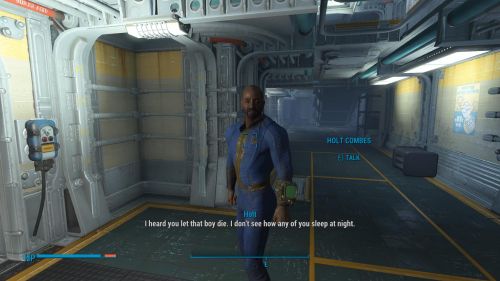
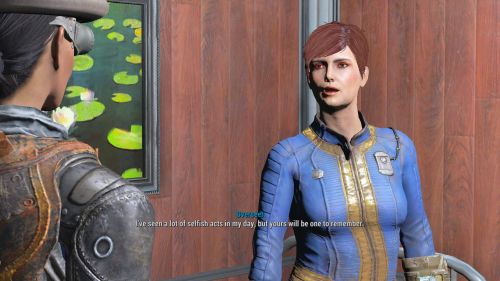
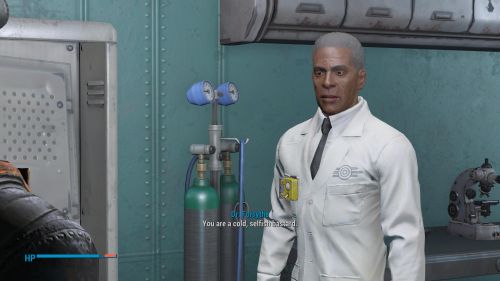

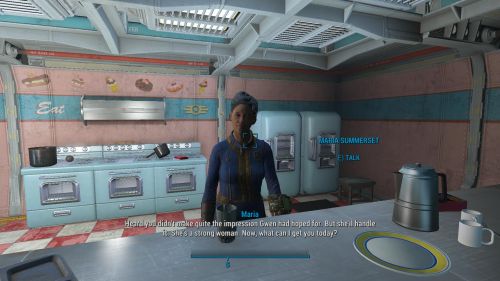
If you let the kid die, the flavour NPCs will hate you forever. Meanwhile, the shopkeepers and service providers will forgive you instantly. Choices and consequences.
Overall, I would rate Fallout 4's quests as “overwhelmingly terrible.” Most of them are totally forgettable, strictly linear trash, and the others are stuck in my mind for all the wrong reasons. There are only a few comparatively bright spots like the “Kid in a Fridge” quest, where the designers have at least attempted to offer a wider range of logical quest resolutions; unfortunately, even those quests are ruined by the game's unfathomably awful writing. The quest writers valiantly keep returning to the game's core themes, like the little boy in distress, the family that's been torn apart, and the lost home. They're trying to say: "this could be you, this could be your missing child, this could be your family - so care about them, god damn you!". But for all their efforts, they never -- not once -- managed to make me care for any of their NPCs. The characters in Fallout 4 are simply too cartoonish to be taken seriously; thus, the stories they are involved in and the decisions they offer can hardly be taken seriously either. Compared to the complex, well-written, and quite simply interesting quests featured in New Vegas and The Witcher 3, Fallout 4's design is shamefully inept.
12. I don't know what Fallout 4's setting is supposed to be about
Let's take a look at Fallout 4's longest and most important side questline. It revolves about the Cabots, an immortal pre-war family who live in an impeccably maintained mansion that sits squarely in the middle of a bombed out warzone. In conversation with the player, Jack Cabot will reveal his family's horrible secret: they have gained immortality by drinking the blood of the family's patriarch, a renowned archaeologist who discovered the lost alien city of Ubar in the Arabian desert and was corrupted by a mysterious “Zetan artifact” that gifted him not only with immortality, but also with the powers of telepathy and telekinesis, as well as imparting upon him a wealth of eldritch knowledge that swiftly drove him mad. The player eventually learns that the madman in being held in an old insane asylum, where he is telepathically manipulating the local raider population into breaking him out.
After a couple of fetch quests and a few hours of corridor shooting, the player is presented with a final choice: they can either choose to unleash this horribly powerful ancient evil into the world and watch daddy Cabot butcher his family before he makes you "immortal" (i.e. ageless, which you already were) as a reward, or they can kill him and make the family mortal again. Since Fallout 4 has no ending slides, we have no idea what the hell the mad alien dad is going to do in the Wasteland; I'm not sure if the quest designers have even put this much thought into the matter, or if it's simply a one-off “release a powerful ancient evil into the world and watch as absolutely nothing happens” kind of deal. On the other hand, if you save the family, Jack will drop a cryptic hint of things to come:
After I finished this questline, I began to wonder: what were the rules of the Fallout 4 world? Was it a gritty post-apocalyptic setting about naked survival and the challenges of rebuilding civilization? Was it a madcap comedy setting with an “anything goes” mentality? Was it a cosmic thriller about alien civilizations taking over people's minds? Still wondering, I took a few steps to the east, where I stumbled across a rocket-powered ancient sailing vessel that was stuck on top of a building; the ship was manned by a crew of malfunctioning robots who spoke in funny accents and thought that the war with China was still going on. I briefly poked my head into a nearby building; it was a super mutant slaughterhouse, decorated from floor to ceiling with hundreds of freshly dripping human livers and kidneys. Even the loot chests were slathered with gore. A stone's throw to the north, I found a small settlement with a dark secret: they were kidnapping, torturing, and murdering innocent travellers in a massive underground facility with the hopes of developing a Blade Runner-style “synth detection test”. The only way to make them stop was to butcher them all. Further east, I found “Dunwich Borers”, a pre-war mining facility that had been infiltrated by an evil cult who had been sacrificing their co-workers to their dark lord.
I looped back west again and found “Pickman's Gallery”, which was inhabited by a serial killing painter who only murdered evil raiders; he used their blood as colour for their paintings. After chatting with the artist, I decided to take a walk to the ocean, where I saw a telescope poking out of the waters; it belonged to a Chinese nuclear submarine that was monitoring the shore. Aboard the vessel was a wise old Chinese ghoul, who deeply regretted his involvement in the war and asked me to help him repair the submarine so that he could die in his home country. I agreed to fix the ship; it wasn't difficult, because all the signs and terminals on board were in English. Finally I swam back to shore, where I stumbled upon a cult who had renounced their earthly possessions in favour of finding enlightenment. They were standing around in a big open space in the middle of a mutant infested city, and they were surviving just fine. As a palate cleanser, I visited the Atom Cats: they were a community of jive-talking greasers who fetishized power armour. Those cool cats spent their days designing custom paint jobs for their suits and racing each other on the local track. To cap off the day, I attended an evening performance by former Wonder Woman Lynda Carter, who performed a truly remarkable original song under her stage name "Magnolia". Afterwards we had a one-night stand, which greatly satisfied her.
That was just a sample of the many rich and diverse experiences I had during my 120+ hours in the Commonwealth. Based on the things I saw and the stories I participated in, I can now tell you conclusively what this game's setting is really all about: in Fallout 4, the wasteland is a run-down amusement park. It's stuffed with hundreds of different “attractions” of dubious quality, each of which seems to exist in a completely different world from its neighbours. Sometimes, you're battling eldritch forces in an old mine shaft; a few hours later, you'll be escorting a sentient mobile brewery to an eager barman. One day, you'll be going to enormous lengths to help a shy DJ find his place in life; the next, you'll be fighting ancient alien powers in the basement of an insane asylum. These locations have no thematic connection to each other, and their placement in the world space follows no discernable logic. An idyllic, unprotected family home will be standing thirty feet away from a camp full of bloodthirsty raiders. A small human settlement is just on the other side of the hill from a massive super mutant installation patrolled by elite units with rocket launchers. A little boy is standing around in an area crawling with ghouls and mirelurks, offering quests to passersby. Empty suits of power armour are just standing around in the middle of the world; none of the NPCs ever find them.
We're asked to believe that this “post-apocalyptic world” has been around for over 200 years, but the world design contradicts this claim at every step. Before your character goes into stasis, they leave their faithful robot butler behind; 210 years later, he is still hovering on your lawn, right out in the open, in the middle of an unprotected suburb surrounded by raider camps and hordes of feral ghouls. His miraculous survival sets the tone for the rest of game. All across the Wasteland, you'll run into nostalgic old ghouls and pre-war service robots, characters who really shouldn't be around in these numbers, and who can't produce any sort of convincing excuse for their continuing survival. The entire world space is still littered with pre-war containers full of precious loot; even the old nuclear power generators are still running flawlessly, with their highly valuable fusion cores just waiting to be plucked out by the player character. Meanwhile, the few tiny, struggling settlements run on oil generators.
The written history of the world is also heavily focussed on pre-war times; you can read the personal diary of the former head janitor at the Boston city hall (“My bitch wife complains that I smell like shit. No shit I smell like shit, I work with shit!”), or the fumbling love letters between two secretaries at the local toy factory, but you'll be hard pressed to find any interesting information about the seven or eight generations of people who lived in the wasteland after the war. What did they do with their lives? Where did they settle? Which settlements failed, and why? How did they deal with resource scarcity, monsters and disease? The writers seem to think that pre-war office romances and a guy ranting about the smell of feces are somehow more interesting or more entertaining than the depiction of everyday life and survival in a post-apocalyptic world.
And that's where I see the fundamental problem with Bethesda's handling of the Fallout setting; they don't seem to have any real interest in clearly defining and developing their world. Combine the kidnapping plot, the synthetic conspiracy, the faction warfare, the alien menace, the eldritch horrors from beyond the veil, the various serial killers, the zany robots, the office romances, the cults, the flying sailing vessels, the kid that spends 210 years in a fridge, as well as all the other bullocks, and you're left with a totally incoherent, fundamentally meaningless unholy mess. Nothing in this setting holds up to the slightest bit of scrutiny; none of the characters, none of the factions, none of the basic elements of world design seem to have any careful thought put into them.
13. Fallout 4 is a bad game
Fallout 4 is a serious game full of caricatures; it's a comedy game without any funny parts; it's a 100+ hour single player shooter; it's a treadmill of linear fetch and kill quests coupled with atrocious writing. It's a shallow and simplistic game that struggles to create an illusion of depth and variety. It is a lazy, nonsensical, and fundamentally dumb piece of design that offers nothing of interest to the discerning cRPG player. I regret every minute I wasted playing this game. There is nothing more to say.






